Catalog
What is the catalog?
The catalog contains all master data from your diagrams that may be reused; such as roles and IT-Systems. The processing and quality assurance of catalog items is available for users with administrator or editor rights to support a central administration of master data.
In modeling, suggested catalog items appear as usual in the modelers’ suggestion list, but can be changed in the diagram. As soon as the administrator or the editor has accepted catalog items, they appear in the suggestion list and cannot be changed by modelers anymore. This reduces the risk of objects being accidentally changed in individual diagrams, which are reused elsewhere and thereby result in unintended side effects.
You can find the Catalog in the menu and open it with one click.
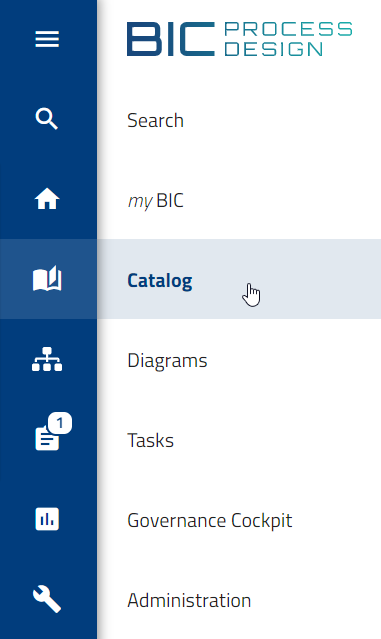
The catalog opens and a list of all catalog items, that you can access, is displayed. This includes the symbol of the type and the name of each catalog item here. In addition, the associated attributes and occurrences can be displayed. You can see the number of currently listed catalog items in the header next to the “Catalog”. If a catalog item includes a description, it is displayed either below the name in the list or within the catalog item.
In the public workspace, accepted catalog items as well as suggested catalog items are displayed in the catalog. You can recognize a suggestion by an orange dot at the icon of the item.

In addition to the list of catalog items you can also use the dashboard to represent some of the data in your catalog graphically.
Create and edit catalog items
How do I create new catalog items?
Depending on your user role, there are three ways to create a new catalog item. First, they are created as catalog suggestions. If you want to publish a diagram, you must accept all catalog suggestions that are modeled in the diagram. The options available to you are described below.
Create catalog items directly in the catalog:
As an Editor or Administrator, you can create catalog items directly in the catalog. To do so, navigate to the Catalog menu item in the left menu bar and switch to the Public workspace if you are not already there. At the bottom right of the catalog view, you will see the New catalog item button.

When you click this button, a dialog opens where you need to enter a name and select the catalog object type. All available catalog object types are displayed in a drop-down list when you click the Choose a type field. Additionally, you will find a checkbox, which is activated by default, that will redirect you to the details of the catalog item once it has been created. If you do not want to be redirected, simply deactivate the checkbox.
If you have previously filtered the catalog items, the filtered object type appears in the Choose a type field when you create a new catalog item. For example, you can immediately see if an object is missing from your organization and create the missing catalog item using the New catalog item button.
To create the catalog item, click the Create catalog item button. To cancel the creation process, click the Cancel button.
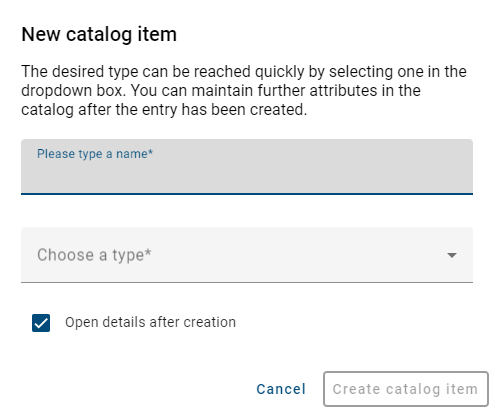
If you activated the Open details after creation checkbox when creating a new catalog item, clicking the New catalog item button will redirect you to the edit mode of the details view of the new catalog item. Here you can define the attributes of the item (e.g., name, identifier, or description). Once you have made all your changes, you can save your changes and exit the edit mode by clicking the Save changes button in the upper right corner. If you do not want to make any changes, you can exit the edit mode directly by clicking the Exit edit mode button in the upper right corner.

Note
Once you have created a catalog item, it will appear at the top of the catalog list. When you reload the page, the catalog item appears in alphabetical order in the catalog list.
Adding catalog items by modeling:
As an Author, Editor, or Administrator, you can add catalog items by modeling a diagram. To do this, navigate to the Diagrams menu item in the left menu bar and switch to the Public workspace stage if your are not already there. Click on a diagram and check it out using the Check out button in the upper right corner.
The new catalog items can be created by modeling new objects in the diagram modeling process. To do this, you must enable the Generate catalog suggestions for this object type during modeling option in the administration area for the object type.
Model a new object in the diagram that can be used in the catalog. These include reusable objects such as roles, risks, and more. Objects that are not available in the catalog by default are, for example, activities and events, as they are usually unique.
To make a modeled object available in the catalog, the diagram must be checked in. Once the diagram is checked in, a catalog item for the object is available in the catalog as a catalog suggestion.
Suggesting existing objects as catalog items:
As an Author, Editor, or Administrator, you can suggest existing objects in the diagram for which no catalog item exists as a catalog item. To do this, navigate to the Diagrams menu item in the left menu bar and switch to the Public workspace stage if you are not already there. Click on a diagram to switch to the diagram view.
You can now create a new catalog suggestion for an existing object directly from the diagram. In this case, the Type section of the Details tab in the right sidebar will not display a corresponding label such as “Catalog suggestion” or accepted “Catalog item”.
Open the context menu of an object in the selected checked in diagram and click the Suggest to catalog option.
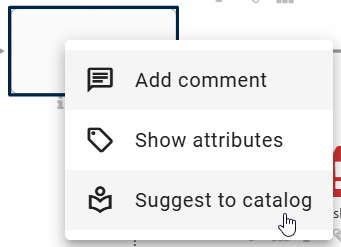
After clicking the option, you will see a confirmation that a catalog suggestion has been added. When you refresh the page, you will see the addition “Catalog suggestion” in the Type section of the Details tab in the right sidebar. If a catalog suggestion or an accepted catalog item already exists for the object in question, the Open in catalog option appears in the context menu.
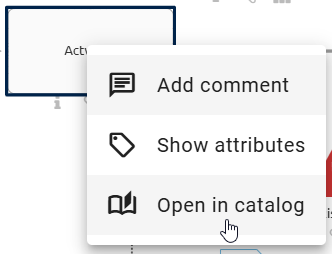
Clicking the Open in catalog option redirects you to the details view of the corresponding catalog item. Here you can make further changes and accept the catalog item.
How do I create new catalog items using AI?
As an administrator and editor, you have the option of generating catalog items using AI. To do this, navigate to the Options panel of the catalog and click on AI-powered Editor.
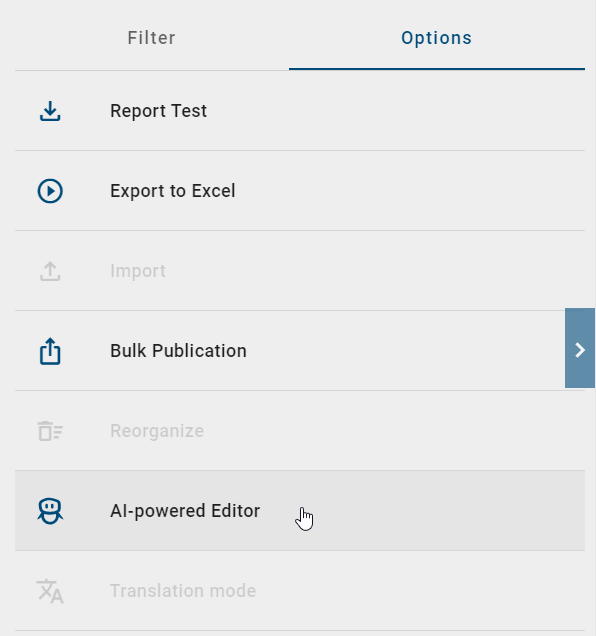
This will open a dialog window where you will need to follow three steps. First, you must inform our AI-powered editor, Arty, of the desired type of AI-generated catalog items. Additionally, you can specify the industry and the quantity of catalog suggestions. Click on Next to proceed to the next step.
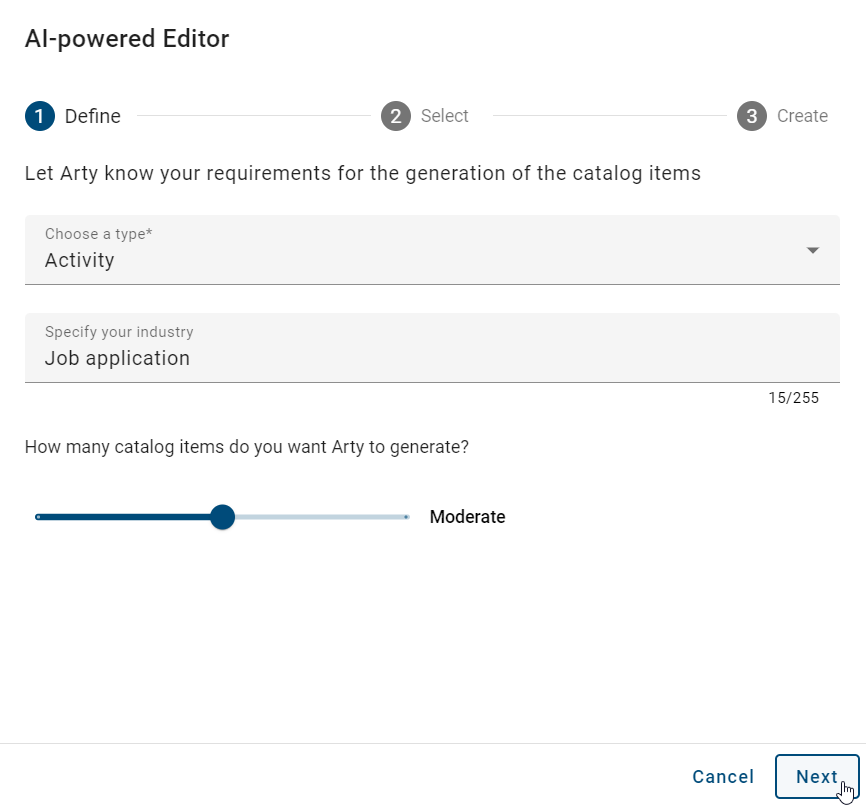
In the next step, Arty generates a range of catalog suggestions. Here, you can select which items meet your requirements. To select all AI-generated suggestions, please click on the top entry Catalog items selected. If you are dissatisfied with the suggestions, you can click the Previous button to adjust your input accordingly.
Once you have selected at least one suggestion, you can click on Next to proceed to the final step.
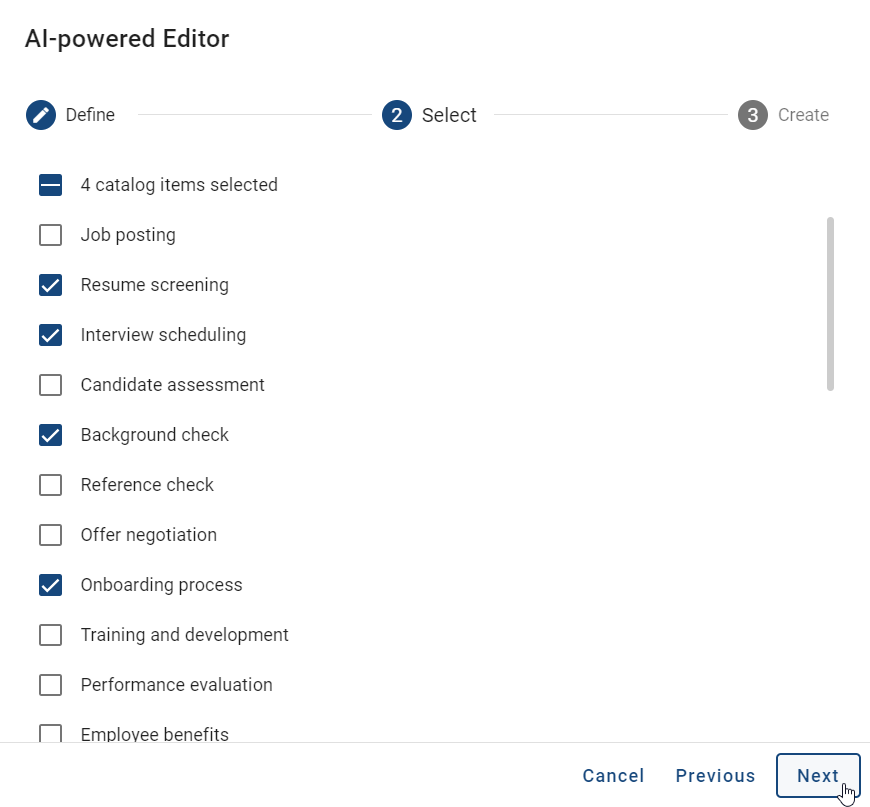
In the final step, you will see an overview of all catalog items generated by Arty. If no errors were identified, you will see a green checkmark next to the suggestions. To view the suggestions in the catalog list, please click the Close button.

The catalog items generated by Arty are now displayed at the top of the catalog list. Once you reload the page, the items will appear in alphabetical order. You can find information on how to edit catalog items here.
Note
Please be aware that the AI-generated catalog items are generated only in the current content language.
Note
The AI-powered Editor option is not available in the mobile view.
Hint
This function is performed by Arty, our AI Editor. Please note, that this function requires a separate license. Please also refer to the notes on using the AI feature.
How do I edit attributes of catalog items?
Navigate to the catalog in public workspace and search for a catalog item that you like to change. Select the item to open the details.

Click the Edit button to enter the edit mode.
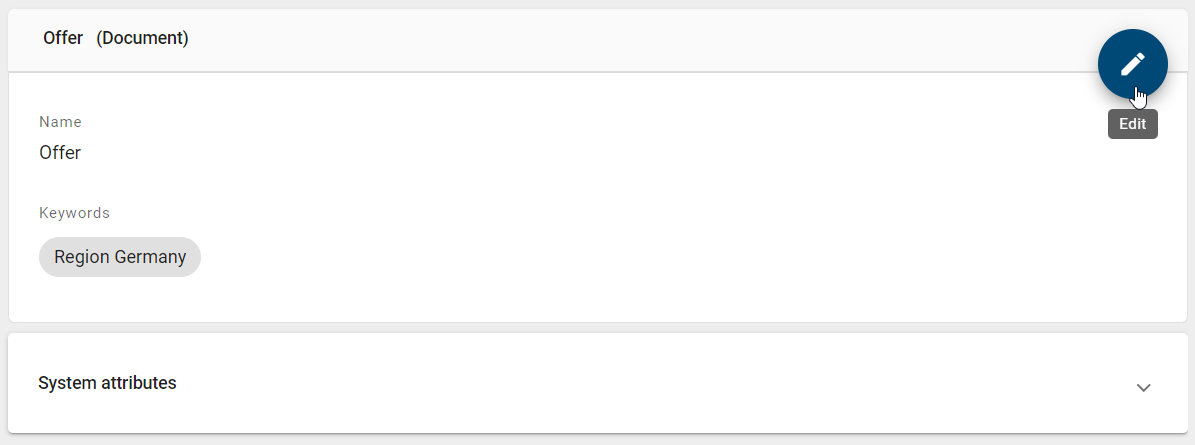
If you are editing a catalog item that is only a suggestion, a small banner at the top informs you about that.

Edit the attributes according to your wishes by changing, inserting or deleting values. Read-only and system attributes cannot be edited. You can add links and files in the attribute field Attachment (URL), which are sorted alphabetically. Permanent links to attached files will only work persistently if the title of the attachment remains unchanged. Once the title is changed, the link becomes invalid, and the attachment can no longer be accessed or downloaded using the generated link. The attachments can be provided language dependent. An explanation for the functionality can be found in the chapter about the attribute “attachment”. Moreover, note the different functionality to edit the attribute “Description”.
Hint
Please note that the Attachment (URL) attribute may be restricted by the individual method configuration. In this case, only links or URLs can be stored, and other file types cannot be used.
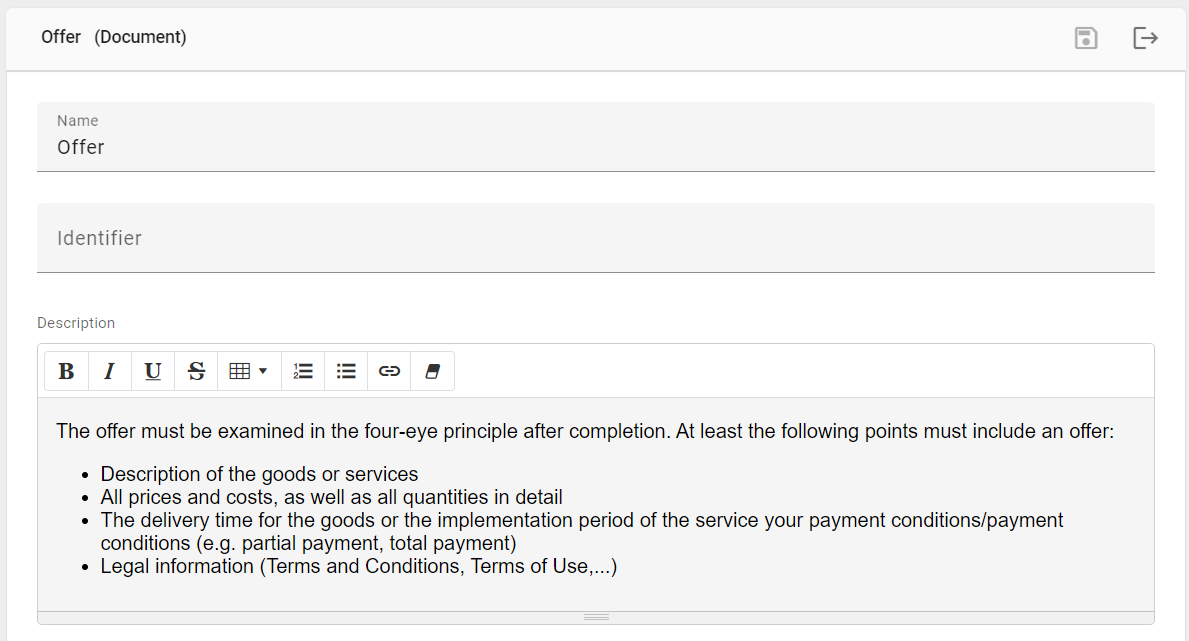
Organizational units, documents and norms can be created while editing the attributes of certain entities in the catalog. To do this, the attribute field must be selected. Suggestions of existing catalog items are shown after the the first letter is entered.
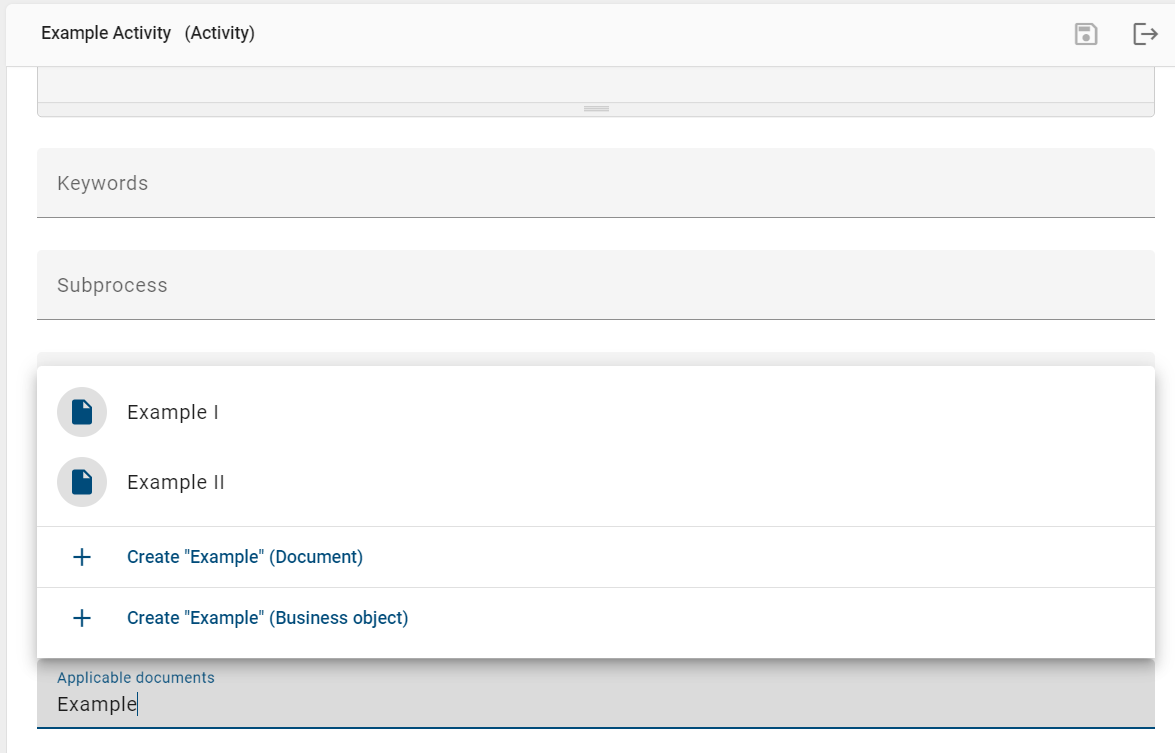
In addition, a new entity can be created and assigned directly. This is done by entering the desired name in the selected field and clicking “create” for the required entity type.

A notification will inform you that chosen entity has been created and added to the publishing workflow for catalog items.
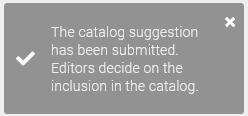
Confirm your changes by selecting Save. You will be redirected to the original view of the catalog item. You can undo your changes via the button Exit edit mode.

If you are leaving the edit mode and there are unsaved changes, you will get a hint. You will have the possibility to save your changes or leave without saving. Alternatively, you can cancel leaving the edit mode by clicking outside of the pop-up window.

Note
In the edit mode you can only see values of properties that have been maintained for the selected content language. Outside of the edit mode you will also see values that have been maintained in the alternative language but not in the content language. This behaviour enables you to be sure that when being in edit mode you will always set up values for the currently selected content language.
Hint
In the edit mode, all options except for *Delete* are deactivated. For example, no catalog suggestion can be approved or rejected during editing.
Tip
If a diagram or object has been added to the details of a catalog item, you can navigate to the corresponding diagram or object by clicking on the chip.
What happens if I change symbol attributes in a diagram that are in the catalog?
If you change symbol attributes in an existing diagram when they have already been accepted in the catalog, a new catalog item is created for this symbol. This serves to prevent unwanted or accidental changes in the attributes of the same symbol. The creation of new items allows you to manage changes centrally in the catalog, for example, to decide whether the changes should also apply to other symbols.
Create a new symbol (for example, a role) and select a catalog item from the suggestion list. The symbol has the same properties as the selected catalog item. If you change the attributes of this symbol, for example, by renaming it, the following happens.

Accepted catalog item
A new catalog item containing the changed attributes is created by checking-in the diagram. Other symbols in the same diagram that previously referred to the same catalog item are also changed and then refer to the new creation mentioned before. However, the symbols of the catalog item that are used in other diagrams do not change and the reference remains. If you want to replace the selected catalog item with the newly created item for these symbols as well, you have to do it via the Delete option.
Proposed catalog item
Check in the diagram and the changes will be accepted for the existing catalog item without creating a new one. These changes also affect all other diagrams in which the proposed catalog item is used.
Note
Be aware that the suggestion list of the server will be updated after you check in your diagram. In other words, if a suggested catalog item is renamed, this item will still have the old name in the suggestion list of the server until you have checked in the diagram once.
Quality assurance in the catalog
How do I change the state of an accepted catalog item?
As administrator or editor you have the possibility to set accepted catalog items back to the status catalog suggestion.
To do that, open the details of the catalog item and open the options menu.
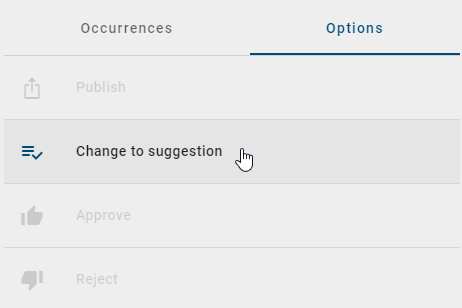
Choose the Option Change to suggestion to set the catalog item to the status of a catalog proposal.
How can I accept a catalog suggestion?
The user roles Administrator and Editor are authorized to manage catalog items and can therefore accept suggestions to include them into the catalog.
Navigate to an existing catalog item in the catalog list that has not yet been accepted. You can recognize such a catalog suggestion by an orange dot at the icon of the item.
You can directly accept the suggestion in the list. Open the context menu (three dots) of the item and select the option Accept.

Alternatively, you can find the same option in the detail view of the catalog suggestion. Click the item, then switch to the Options tab in the right sidebar and select Accept.

As soon as you accepted the suggestion, it will be added to the catalog and thus will be part of the master data of your repository.
If an object of the approved catalog item is changed in a diagram, the item in the catalog is not changed but a new catalog item is created instead. Changes for reuse of the accepted item can thus only be made via the catalog itself.
Tip
You can filter suggested catalog items in the catalog.
How can I reject a catalog suggestion?
Items that have been rejected in the catalog are removed and no longer available for reuse in any diagrams (via the suggestion list). As an Administrator or Editor you can reject proposed items from the catalog as follows.
Navigate to an existing catalog item in the catalog list that has not yet been accepted. You can recognize such a catalog suggestion by an orange dot at the icon of the item.
You can directly reject the suggestion in the list. Open the context menu (three dots) of the item and select the option Reject.

Alternatively, you can find the same option in the detail view of the catalog suggestion. Click the item, then switch to the Options tab in the right sidebar and select Reject.

As soon as you reject the catalog suggestion, it will be removed from the catalog. Until the page is updated, the item will be displayed strikedthrough. This action cannot be undone.
How can I contact the creator of a catalog item?
As an Editor or Administrator, you can contact the creator of a catalog item to clarify any ambiguities. To do this, click on the Catalog menu item in the left menu bar and select a catalog item. You can choose from both catalog suggestions and accepted catalog items.
After clicking on a catalog item, you will be taken to the details view of the catalog item. In the Options panel on the right sidebar, you will find the Contact creator option.

When you click the Contact creator option, your email program opens, allowing you to compose a new email. The creator’s email address is automatically entered in the “To” email field, enabling direct contact. If no valid email address is available for the creator, you will receive an error message.
Search and filter catalog items
How do I search for catalog items in the catalog?
If you open the Catalog menu item in the left menu bar, all catalog items that are stored in the current repository are listed in the main area. You have the option of searching for items using the search function in the Catalog area.
To search for specific catalog items, you must click on Search catalog list in the Filter tab at the top right of the catalog. To start a search, enter the name of the desired catalog item and confirm the entry with the Enter key or by clicking on the magnifying glass symbol.

You will then see all the search results that contain the specific name.
If there are no matching catalog items for your search term, the main area will show a corresponding hint as well as the button Toggle language & search again. You can select this button to set the alternative language as your content language and restart the search in this new content language.
If you want to display your entire catalog list again, click Clear search next to the magnifier glass icon to reset your list.
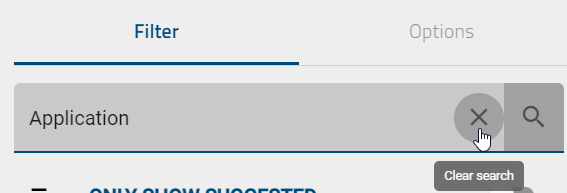
Hint
Here you can find an overview of the different options you have for search terms.
Note
The search results are sorted by relevance. Therefore, it is not possible to sort them by name.
Warning
Please note that searching for catalog items within access-restricted diagrams is only possible for their governance participants. This also applies if you have the Administrator user role. Changes to users or user groups in the Administration may cause access restrictions to stop working correctly. Therefore, make sure that user and user group information in the administration and the catalog is maintained consistently.
How can I filter catalog items?
Navigate to the Catalog.

There, in the right sidebar you can choose between the register cards Filter or Options. In case you are using a mobile device you can find the filters via the three dotted menu in the upper right corner. If the register card Filter has been selected, filters for all available object types in the catalog are listed. If you click on the desired filter, it will be expanded and automatically applied to the catalog. Additionally, the selected filter will be visually enhanced by a checkmark on the corresponding item.
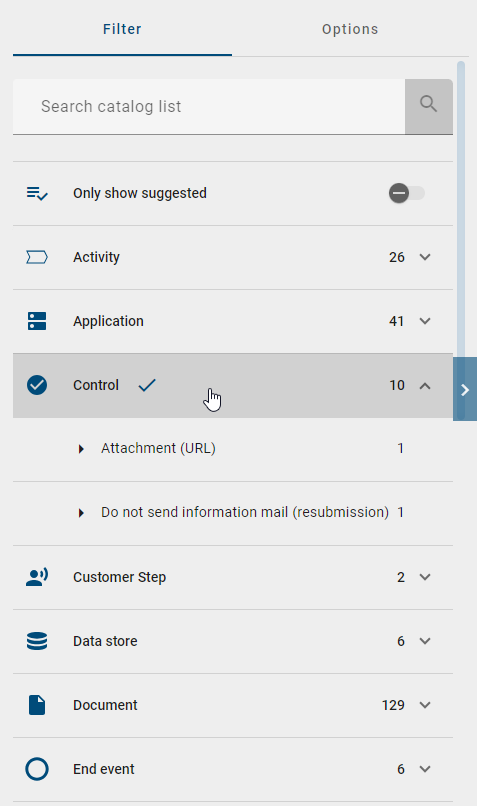
The catalog only displays items of the selected type, as you can see in the header of the catalog. After expanding the filter, individual facets are displayed for the selected entity type. A facet corresponds to an attribute type of the object type and is listed here as soon as it has been maintained on an object and activated in the administration area. The order is alphabetical. Attribute types that include checkboxes or assignments to persons are not taken into account here. The facets can also be expanded. The attribute values of the object type appear and are always listed dependently of a search term. Each attribute value has a checkbox and can be selected and deselected to limit the search to that value.

You can now select more facets, search within the filter, or remove the filter. By collapsing the filter or facet, all filter and facet settings are reset. Note, that you cannot select two filters at the same time.
As an administrator, editor or author you also have the possibility to filter only catalog suggestions. To do that, use the toggle button on the top of the right sidebar. Depending on the stage you are currently in, the button will be labeled differently and you will get different results. If you are in the public workspace, you will get only suggested catalog items. If you are in the preview stage, you will only see catalog items that need approval. It is possible to combine this filter with other filters.

Filters, which have no corresponding catalog items can be hidden within the administration area. To do so use the option to automatically generate catalog items, when checking in. In case this option is deactivated the affected filter will be hidden. This filter will then only be displayed if catalog items for this object type already exist or in case a new catalog item has been manually created in the catalog.
How can I filter catalog items by their current state?
With the Governance Lifecycle filter, you can filter catalog items according to their currently active workflow, their publication or their revision. This gives you a better overview of the status of the catalog items.
If you want to apply this filter, you must be in the Public workspace. In the Filter tab, you can open the Governance Lifecycle filter.
Publication
If you open the Published subfilter and at least one catalog item has been published, you can filter for the corresponding catalog item by clicking on Depublished, Not published or Published.
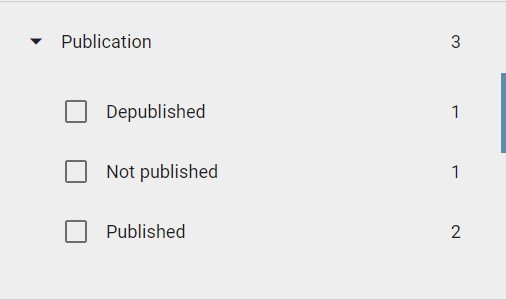
Revision
If the Revision subfilter is expanded and at least one catalog item has a revision status, you can select a specific revision status as a filter. You can filter catalog items according to the following revision statuses: Modified, Unmodified and Unknown. Changes to a catalog item cannot be displayed until it has been republished. Until then, it has the revision status Unknown.
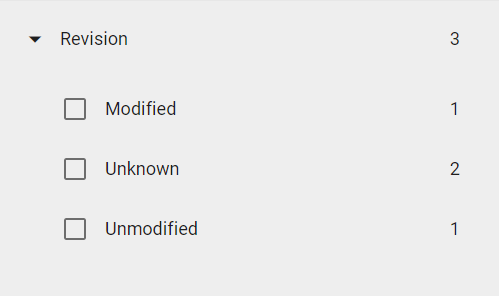
Workflow
If you have expanded the Governance Lifecycle filter, you also have the option of opening the Workflow subfilter. Here you can then filter whether a workflow is active for the catalog item. A distinction is made between Depublication, Publication and Resubmission.
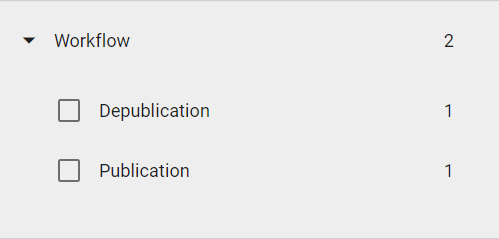
You will then see a filtered list and a number of all catalog items that are in the corresponding area.
Hint
The Governance Lifecycle filter is available from version 7.14.0. To display all published catalog items in the filter, you must check the catalog items out and back in at least once.
Note
All filtered results are sorted alphabetically by browser language.
Hint
The Governance Lifecycle filter is also available to filter diagrams by their Workflow, their Publication or their Revision.
How can I add attributes to the catalog list view and get a table view?
Each user has the possibility to add attributes to the catalog’s list view to create a table view. To do this, go to the Catalog menu item in the left menu bar and, if necessary, switch to the Options panel in the right sidebar. There you will find the Adjust table option.

After clicking this option, you will see a list of all available attributes sorted by attribute type that you can add to the list view. A selected attribute is marked by a check mark. If you cannot find a specific attribute at first glance, you can use the search bar to search for it. The search is not case sensitive.
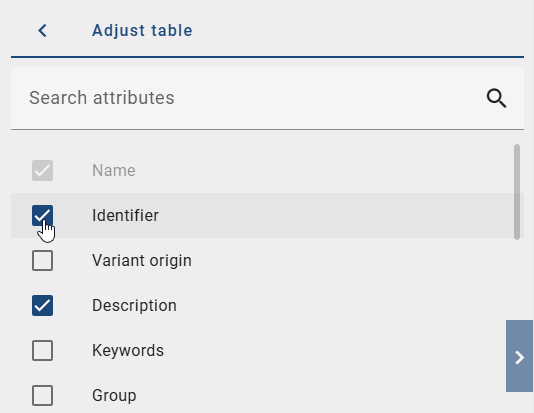
Once you have selected at least one attribute, it is immediately displayed as a new column heading in the list view in your active browser language. The maintained content for each catalog item will be displayed in the active content language. If an attribute value is only maintained in the alternative language while your content language is active, the content from the alternative language will be shown. If the attribute value is not maintained in any language, the content for the corresponding catalog item remains empty. Alternatively, the content remains empty if the attribute type is not assigned to this object type. You can find out the exact reason for the empty content by hovering the mouse over the empty entry.

If the number of attributes displayed exceeds the capacity of the desktop view, a horizontal scrollbar will appear, allowing you to scroll through the various attributes. Your customized table view is saved and will be shown the next time you access the catalog. You can modify the display of attribute values at any time.
Note
The name attribute is always displayed and cannot be changed.
Bulk Update
When you open the Catalog menu item in the left menu bar, all catalog item in the current repository are displayed in the main area. If you want to edit several similar attributes in different catalog item at the same time, you can use the Bulk Update function. This feature is available for the Editor user role in the Public Workspace and for the Administrator user role in all areas.
To apply the bulk update function, first open the Filter tab in the catalog view and then filter for the desired object type. This updates the catalog list and displays only the filtered items in the currently set user interface language. Then switch to the Options tab on the right side of the catalog view and select the Bulk update option.

You will then be in bulk updating mode. All filtered catalog items will be displayed as a list view. Select the catalog items you want to edit and click Start bulk update.
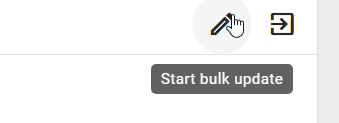
After you have started the bulk update, a dialog opens in which you can configure the desired change. Now select the attribute type you want to edit. You can then specify which action should be applied to this attribute. The available actions are: replace attribute value, remove attribute value, or add attribute value to an existing value. Depending on the action you select, corresponding input fields will appear in which you can enter the desired attribute value. As you type, the system will display the available values for the selected attribute type from the current range, allowing you to select one directly.
Add attribute value:
If you have selected a multi-value attribute and open the action menu, specify the attribute value you want to add.
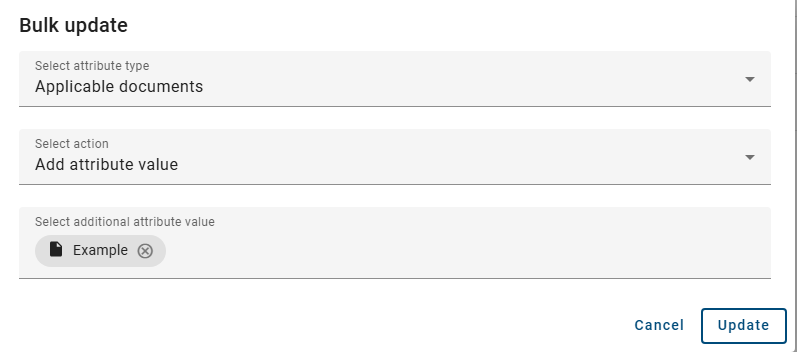
Hint
Please note that if you add another attribute to a single value attribute type even though a value already exists, the affected catalog object will be skipped during Updating. After the Update, you can download a JSON file from the bottom right corner of the screen. In the downloaded JSON file, the affected catalog object appears under Catalog objects not updated, including the corresponding entity ID, the name in the content language you selected, and the specified reason.
Replace an attribute value:
If you want to replace an attribute value, enter both the existing value and the new value.
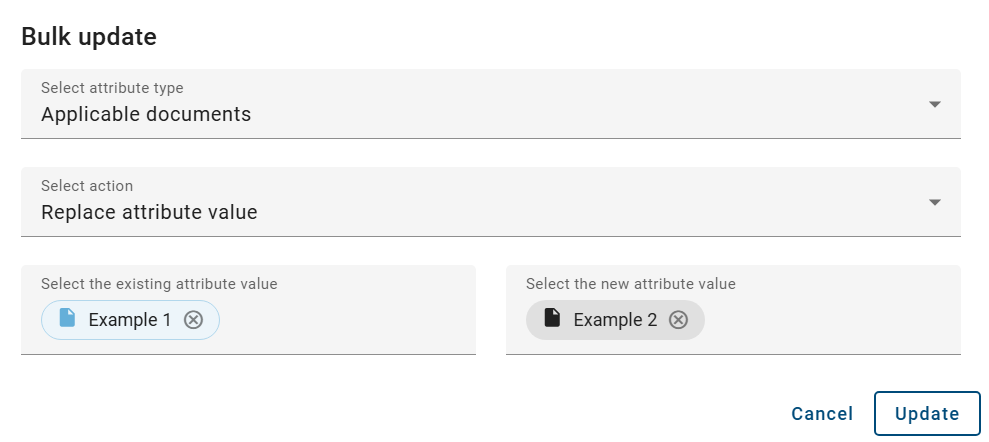
Note
Please note that the attribute value is only replaced in the current content language.
Remove attribute value:
If you want to remove an attribute value, simply specify the value you want to delete.
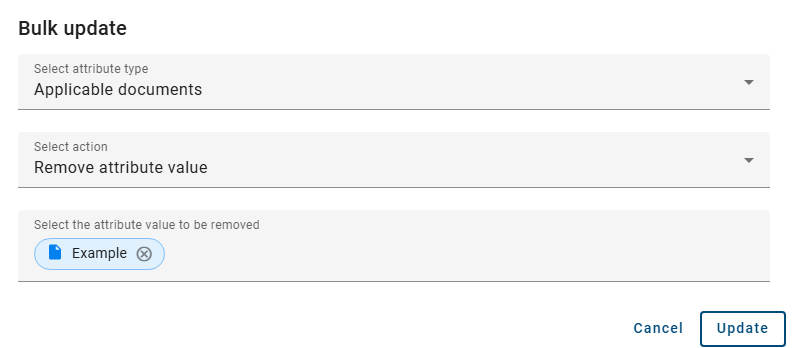
Then click Update to apply the changes or Cancel to discard them. If you want to remove your selected attribute value, click the X on the chip.
After clicking Update, a confirmation window will open. Enter the word update in the text field to confirm the bulk update.

After successfully updating the corresponding attribute values in the selected catalog objects, a message will be displayed showing how many of your selected catalog objects could be updated.
If you want to exit the bulk update, click the Exit bulk update button.
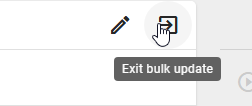
Hint
Please note that after the update, you can download a JSON file in the lower right corner of the screen. This file lists successfully updated catalog objects under Catalog objects updated. Objects that could not be updated appear under Catalog objects not updated and also contain the respective catalog ID, the name in the selected content language, and the reason for the failed update.
Note
Please note that you must have selected at least one object type for bulk updating.
Note
Please note that only one attribute value can be added in bulk updating.
Translate catalog items
As an Administrator or Editor, you have the possibility of making catalog items available in other languages and receiving automatic translation suggestions for the catalog.
How can I make catalog items available in other languages?
As Administrator or Editor you have the possibility to translate all catalog items. This is only possible if you have previously filtered the catalog list. As an Author you can only translate the filtered catalog items you are assigned to. To translate the catalog items, go to the option area and click Translation Mode.
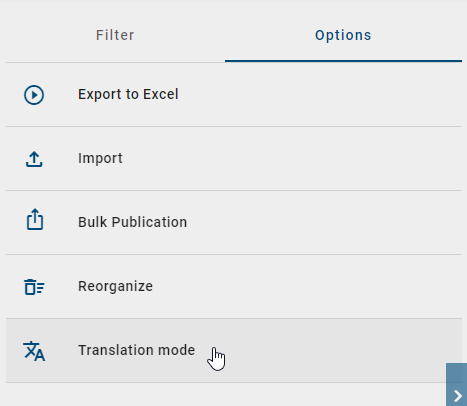
Hint
The option Translation Mode will only be shown if you are in the Public Workspace stage.
After selecting the Translation Mode option, the catalog items will be displayed in your content language. To now insert an alternative language, click on the catalog item in which you want to add a translation.
A list of filtered catalog items appears to translate the language-dependent attributes. After clicking on a catalog item, several text input fields appear where you can enter the name, description, and keywords in another language. The language codes (two-letter codes following ISO 639-1) indicate which text field the translation should be entered into. You can use the horizontal scroll bar to view all supported languages by BIC Process Design and provide translations.
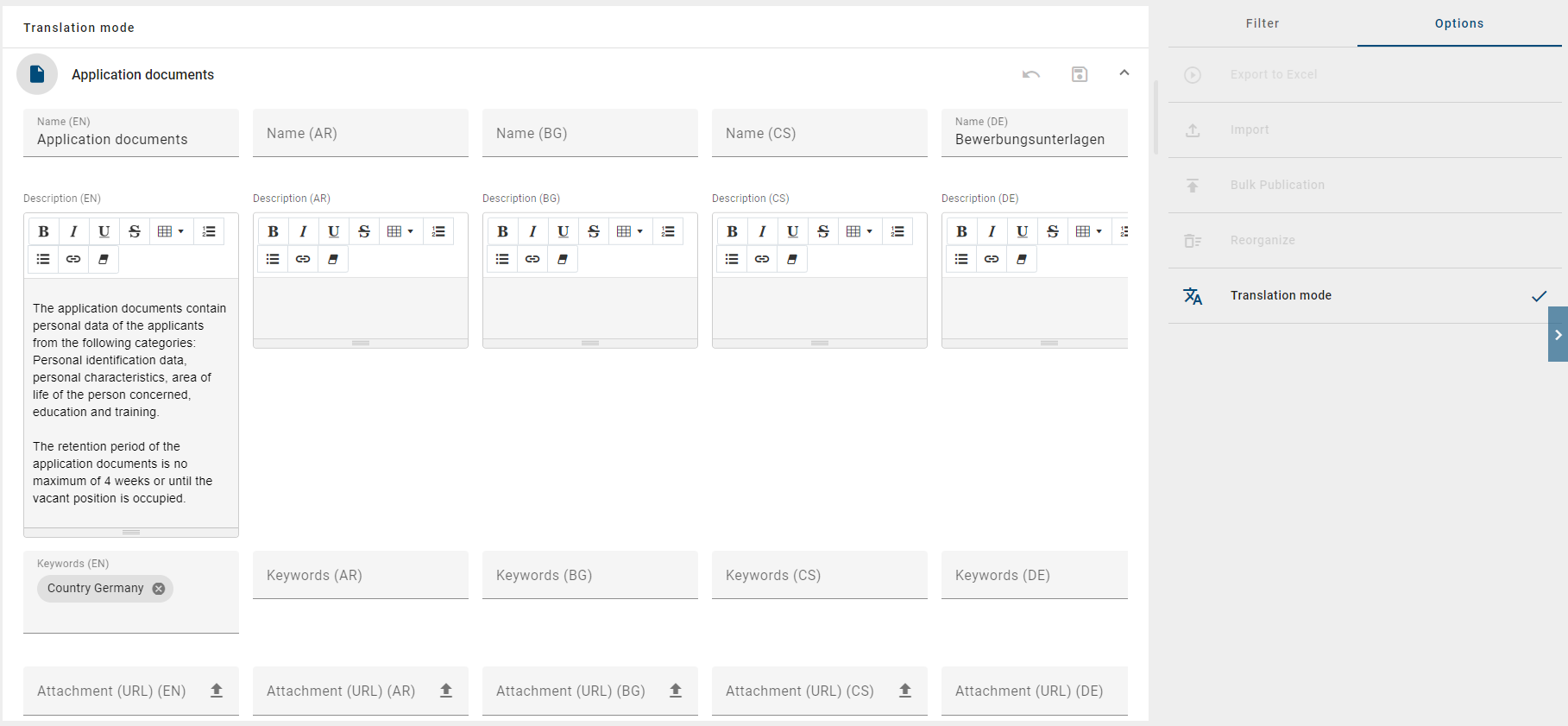
After entering the translations, you can either save or discard the changes by clicking on the Save icon or the Discard icon in the changed catalog item.
Hint
The function save changes is only available per entry and not for all entries together. This allows you to save changes or modifications to a single entry, but it is not possible to save all entries at once.

To leave the Translation Mode, you can either click on the Translation Mode option again or click on your next destination in the application. If you have unsaved changes, a dialog window appears with the according hint. You can decide if you want to discard the changes by clicking on the Leave button or go back to your modified catalog item and save the translation(s) by clicking on the Cancel button.

Note
The option Translation Mode is not available for small screen sizes (e. g. in the mobile view).
How can I automatically receive translation suggestions in the catalog?
As Administrator or Editor you have the possibility to get translation suggestions for all catalog items. This is only possible if you have previously filtered the catalog list. As an Author you can only translate the filtered catalog items you are assigned to. To translate the catalog items, go to the option area and click Translation Mode.
If the DeepL translation service is enabled, you can generate translation suggestions for attributes Name, Description, and Keywords in other languages. To do this, only a language-dependent attribute needs to be maintained in the active content language, which serves as the basis for the translation suggestion.
The option for the translation suggestions is automatically disabled if an input field already contains text. Conversely, the option is activated automatically when an input field’s existing input is removed.
If you want to request a translation for a language-dependent attribute, select the Create translation suggestion option in the respective input field. This will send a request to the DeepL API, which will automatically generate translation suggestions.
EAM context reference
What is a EAM context reference and how can I view them?
If BIC EAM has been purchased and activated, all users can view EAM context references in the catalog. These are business capabilities or applications stored in a business capability context diagram or application context diagram as context references. How to store EAM context references can be found here.
If EAM context references exist, you can view them in the catalog. To do so, click the Catalog menu item in the left menu, then open a catalog item of the type “Application” or “Business Capability”. If the item was previously stored as a context reference, an additional attribute group will appear in the details view. This attribute group is labeled with the name of the context diagram in your current content language. You can expand it by clicking on the attribute group.
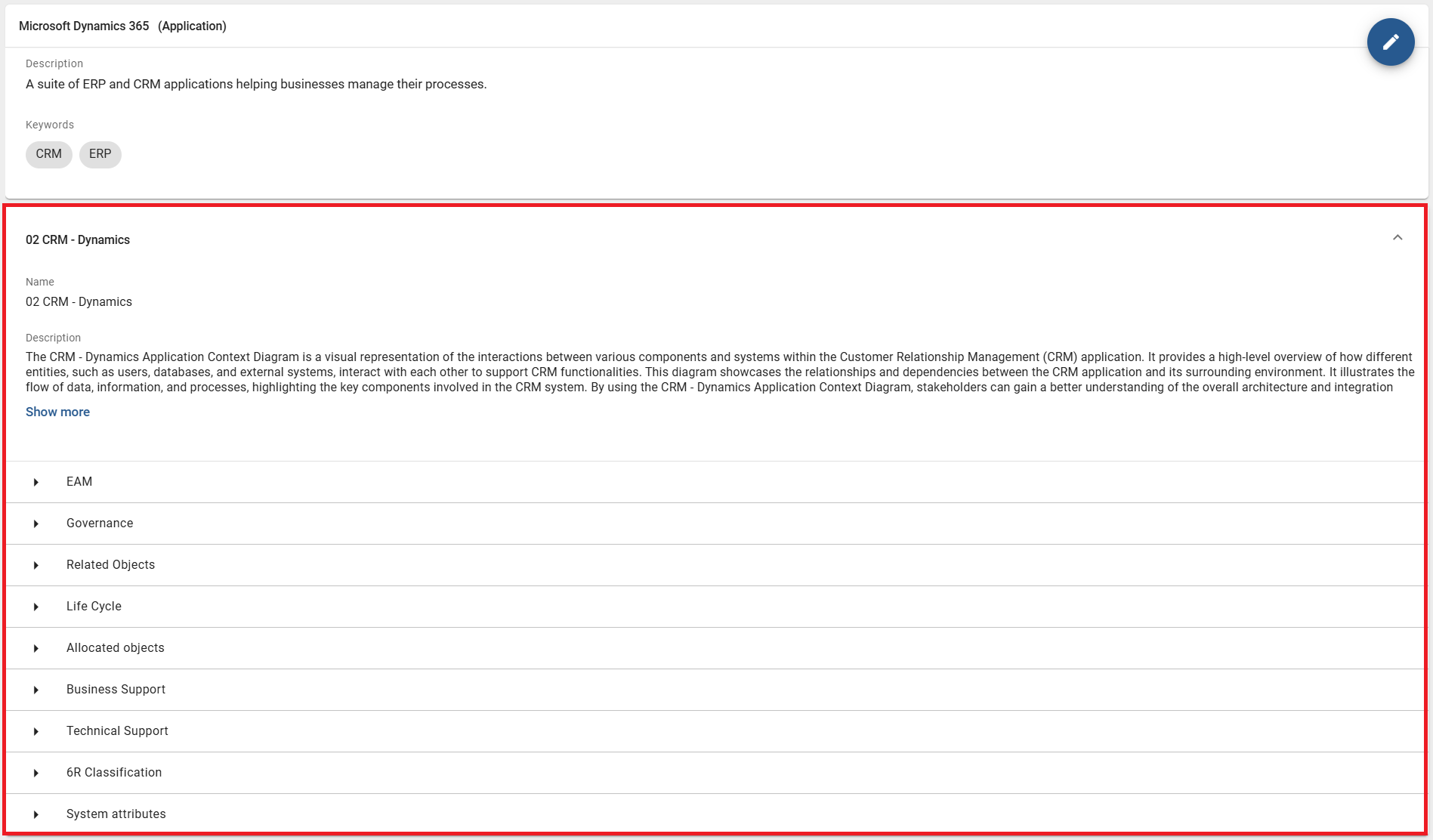
Once expanded, you will see both the details of the context diagram and the node attributes of the selected catalog item that was stored as a context reference.
Hint
If the context diagram has access restrictions, the attribute group will still be displayed, but an error message will appear when expanding the attribute group.
How do I store a EAM context reference?
If BIC EAM has been purchased and activated, users with at least the Author role (provided that the author is entered in the diagram’s Author attribute) can store EAM context references in the catalog. To do so, select the Diagrams menu item in the left menu bar, open a business capability context diagram or application context diagram, and check out the diagram by clicking on the Check out button.
In the Details panel on the right sidebar, the EAM attribute group will be displayed. When you expand this attribute group, you will see the Context Reference input field. Here, you can assign a catalog object of the type “Business Capability” for business capability context diagrams or “Application” for application context diagrams.

After saving and checking in the diagram, an additional attribute group with the name of the context diagram in your current content language appears in the detail view of the stored catalog object. This attribute group includes both the context diagram’s details and the node attributes of the stored catalog item.
Hint
Please note that you can only store one context reference per diagram.
Hint
If the context diagram has access restrictions, the attribute group will still be displayed, but an error message will appear when expanding the attribute group.
How can I view the details of linked attributes of a context diagram?
If BIC EAM has been purchased and activated, users with at least the user role Author (provided the author is entered in the Author attribute of the diagram) can also view the attributes of related objects in the catalog.
To do this, go to the Catalog menu item in the left menu bar and open a catalog item of the “Application” or “Business Capability” type. If the catalog item was previously stored as a context reference or was created using the catalog, an additional attribute group with the name of the context diagram in your current content language appears in the details view. Expanding this attribute group displays all maintained attributes of the context diagram as object chips in relation to the catalog. Each of these chips represents an object linked to the context, for example a “Business Capability” or an “Application”.
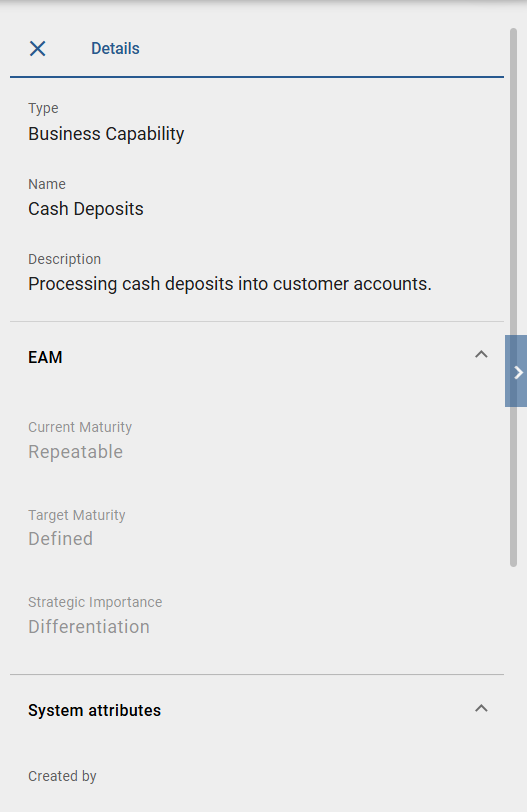
As soon as you click on an object chip, its details open in the right sidebar. This includes general attributes and, if available, node attributes. This view allows you to view the individual objects’ details without leaving the catalog.
In the details view of the right sidebar, you also have the option to click on a linked object chip to display the attributes of the selected object. This allows you, for example, to view specific assignments or relationship attributes from the context diagram.
To close the attribute view, click the Close details option in the top left corner of the right sidebar.
Tip
When displaying relationship attributes in the catalog view, you can navigate directly to a linked object by clicking on the corresponding object chip. This allows you to follow relationships step by step and move from one object to the next without having to return to the initial view each time. You can return to previous objects at any time using the Back button in BIC Process Design or your browser’s navigation.
How can I create an EAM context reference in the catalog?
If BIC EAM has been purchased and activated, users with at least the user role Author (provided the Author is entered in the Author attribute of the diagram) have the option of creating one or more context references for an application or a business capability in the catalog.
To do this, go to the Catalog menu in the left menu bar and open a catalog item of the “Application” or “Business Capability” type. After selecting an “Application” or “Business Capability” catalog item from the list, you will find the Create context option in the right sidebar on the Options panel.
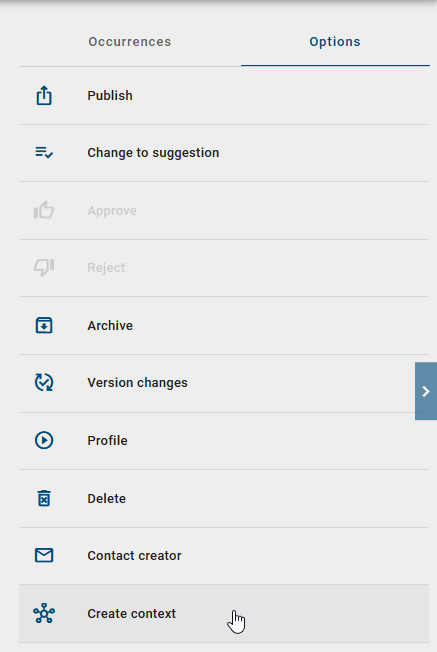
As soon as you click on the Create context option, a dialog opens in which you have to enter a name for the new context diagram.

After entering the name and confirming its creation by clicking the Create option, a new application context diagram or business capability context diagram is automatically generated. This context reference is then displayed as a new attribute group in the details view of the catalog object.
Hint
When a new context diagram is created, the currently open application or business capability is automatically stored as the parent object in the system. At the same time, the diagram is marked as a context diagram created in the catalog.
How can I delete an EAM context reference?
If BIC EAM has been purchased and activated, users with at least the user role Author (provided the author is entered in the Author attribute of the diagram) have the option to delete EAM context references in the catalog.
To do so, go to the Catalog menu item in the left menu bar and open a catalog item of the “Application” or “Business Capability” type. If the item was previously stored as a context reference or was created using the catalog, an additional attribute group will appear in the details view. This attribute group is labeled with the name of the context diagram in your current content language. A context menu will appear on the right side of the attribute group. By clicking on the context menu, you can delete the EAM context reference using the Delete option.

After selecting the Delete option, a confirmation dialog will open in which you have to confirm the action. Clicking the Delete option again removes the context diagram and closes the dialog. Clicking the Cancel option cancels the process and closes the dialog without making any changes.
How can I edit an EAM context reference?
Once BIC EAM has been purchased and activated, users with at least the Author user role (provided that the author is entered in the Author attribute of the diagram) can edit EAM context references of applications and business capabilities in the catalog.
To do this, go to the Catalog menu item in the left menu bar and open a catalog item of type “Application” or “Business Capability”. If a context reference has previously been stored for a catalog item or created via the catalog, an additional attribute group will appear in the details view with the name of the context diagram in your current content language.
If the context reference was created via catalog modeling, you will find the Check out button on the right side when expanding the attribute group of the context reference and can check out the application context diagram or business capability context diagram. If, however, the context reference was stored via diagram modeling, the option to edit the diagram is not available. By checking out the diagram, it is locked for other users and released for you to edit. Only then can you make changes to the contents of the diagram.

While the diagram is checked out, you are in edit mode and can make all inputs and adjustments. By using the Check in option, your changes will be saved. At the same time, the diagram is automatically checked back in and is then available to other users.
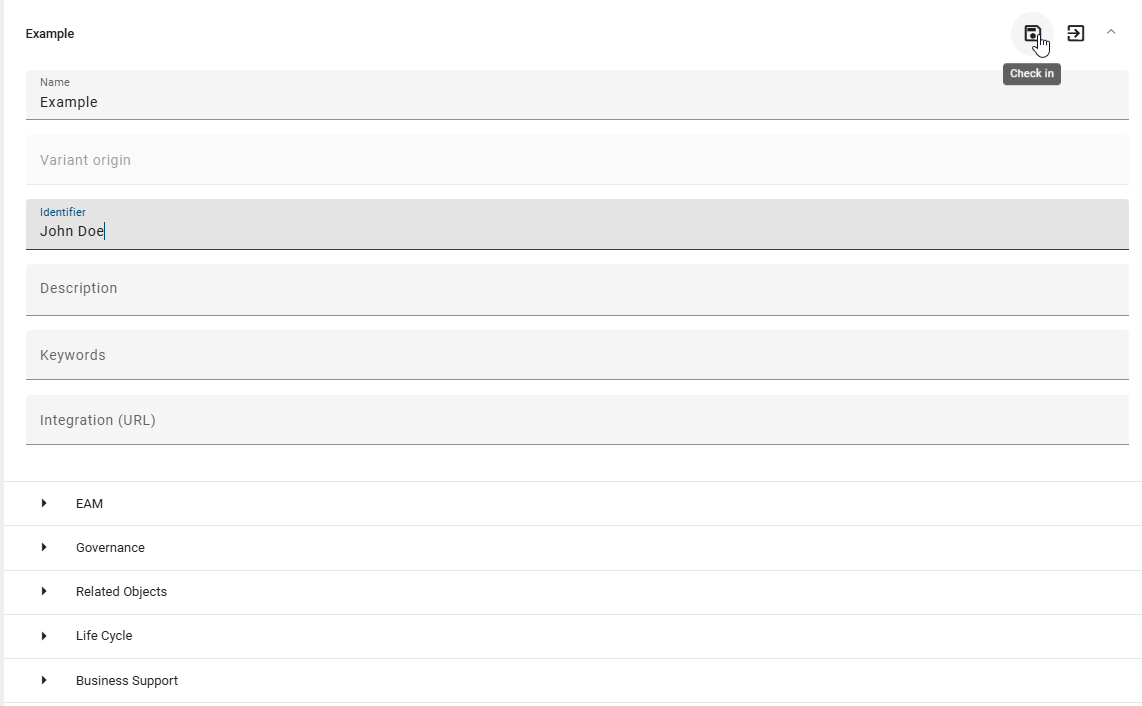
If you want to leave the edit mode while unsaved changes are present, you will receive a notification. Here you can choose to save your changes via the Save changes button or leave the edit mode without saving via the Leave without saving button. If you do not save your changes, you will return to the details view and your changes will be lost. Alternatively, you can cancel leaving edit mode by clicking outside of the notification.

You also have the option of editing the attributes of objects that are linked to each other using relationship attributes in the checked-out context diagram. If you click on such a relationship attribute, the attributes of the associated object are displayed in the right sidebar under the Details tab and can be adjusted there directly. It is also possible to add further related objects to the objects already linked in the context reference. You can also view and edit their attributes by clicking on the chip of the linked object in the sidebar. The Close details button takes you back to the previous view.
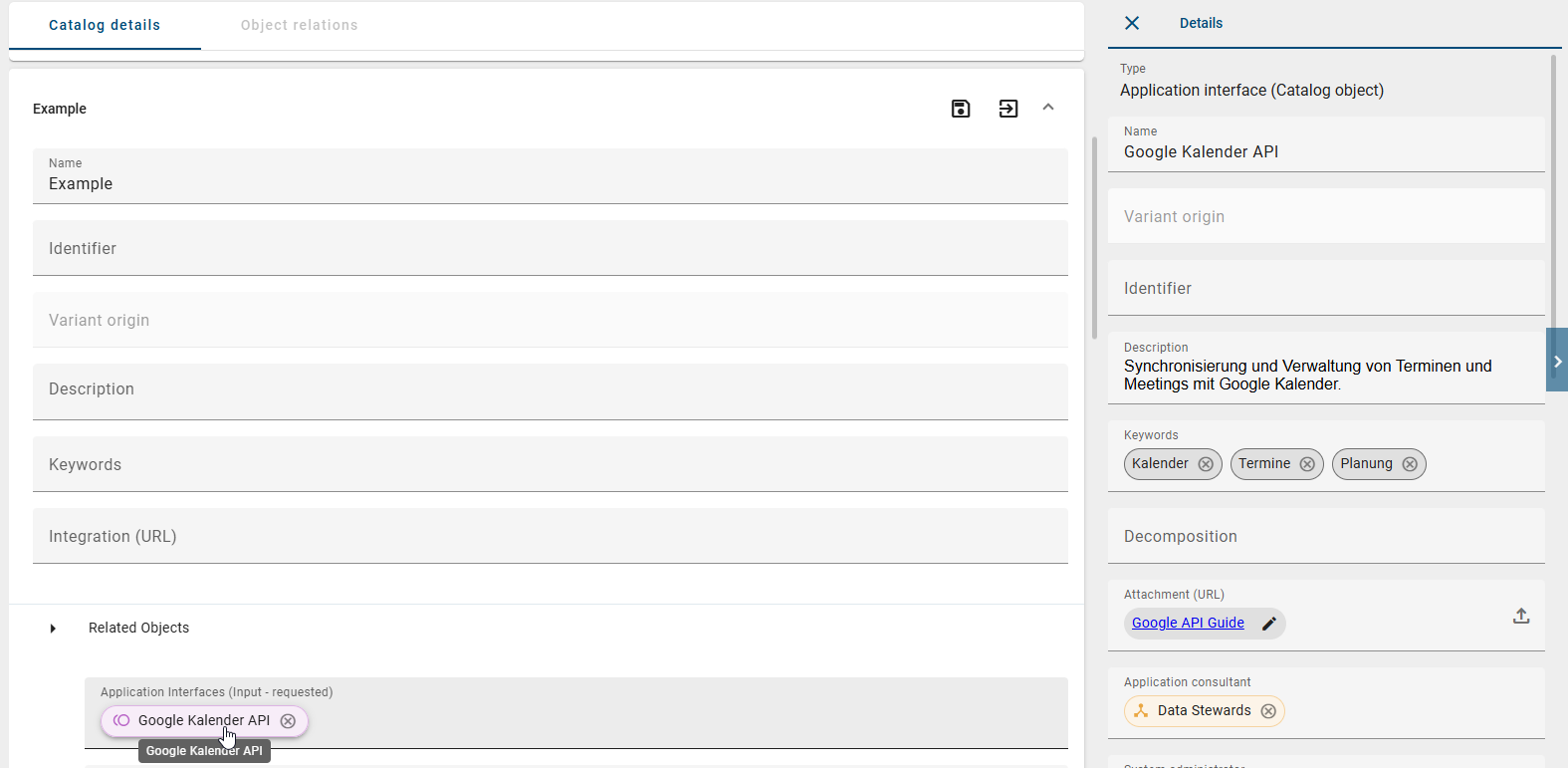
Hint
Please note that the functions described only apply to objects that are linked to each other via relationship attributes. Other assignments, which are also displayed as chips, can be displayed but not edited.
Warning
Please note that when a linked object is deleted, all other linked objects are also deleted.
Note
If a context diagram is currently being edited by another user, it is locked for you. In this case, a symbol appears clearly indicating the locked state. If you hover your mouse over this symbol, the name of the user who has currently checked out the diagram will be displayed.
Tip
When displaying relationship attributes in the catalog view, you can navigate directly to a linked object by clicking on the corresponding object chip. This allows you to follow relationships step by step and move from one object to the next without having to return to the initial view each time. You can return to previous objects at any time using the Back button in BIC Process Design or your browser’s navigation.
How can I publish an EAM context reference?
If BIC EAM has been purchased and activated, users with at least the user role Author (provided the Author is entered in the Author attribute of the diagram) have the option of publishing EAM context references in the catalog.
To do this, go to the Catalog menu item in the left menu bar and open a catalog item of the type “Application” or “Business Capability”. If the catalog item was previously stored as a context reference or was created using the catalog, an additional attribute group with the name of the context diagram in your current content language appears in the detail view. You will find a context menu on the right side of the attribute group. By clicking on the context menu, you can publish the EAM context reference using the Publish option.

After clicking on the Publish option, a dialog opens where you must enter the reason for the publication and confirm the case. Click on the Publish option to publish the context diagram and close the dialog. If you click the Cancel option, the case is canceled and the dialog is closed without any changes being made.
Note
Please note that the context diagram can only be published if a responsible has been entered in the diagram and the associated catalog object is not a catalog suggestion. If this is not the case, you will receive an error message when you try to publish the diagram.
How can I depublish an EAM context reference?
If BIC EAM has been purchased and activated, users with at least the user role Author (provided the author is entered in the Author attribute of the diagram) have the option of removing EAM context references from the publication in the catalog.
To do this, go to the Catalog menu item in the left menu bar and open a catalog item of the “Application” or “Business Capability” type. If the catalog item was previously stored as a context reference or was created using the catalog, an additional attribute group with the name of the context diagram in your current content language appears in the details view. You will find a context menu on the right side of the attribute group. Click on the context menu to depublish the already published EAM context reference using the Depublish option.

After you have clicked on the Depublish option, a dialog opens. Here, you must enter the reason for depublication and confirm the process. Clicking on the Depublish option again removes the context diagram from the publication and closes the dialog. Clicking the Cancel option cancels the process and closes the dialog without making any changes.
Note
Please note that you need to be in the publication stage in order to depublish a context reference.
How can I create a variant from an EAM context reference?
If BIC EAM has been purchased and activated, users with at least the user role Author (provided the author is specified in the Author attribute of the diagram) have the option of creating variants from EAM context references in the catalog.
To do this, go to the Catalog menu item in the left menu bar and open a catalog item of the “Application” or “Business Capability” type. If the catalog item was previously stored as a context reference or was created using the catalog, an additional attribute group with the name of the context diagram in your current content language appears in the details view. You will find a context menu on the right side of the attribute group. Click this menu and select the Create variant option to create a variant of the EAM context reference.

After clicking the Create variant option, a dialog opens. Enter the name for the variant and confirm your entry by clicking the Create option. A variant of the context diagram is then generated, and the dialog closes. Clicking the Cancel option cancels the process and closes the dialog without making any changes.

After you click Create, a variant of the context reference is created and a confirmation message appears in the lower right corner of the screen. The new variant is shown as an additional, initially collapsed attribute group in the detail view and can be edited like any other context.
Note
Please note that creating a variant of a catalog item does not automatically create variants of the associated context references. Variants of context references must be created separately
Note
Please note that you must not be in edit mode when creating an EAM context reference variant.
Dashboard
What is the dashboard and what options does it offer to display the data?
You can display all catalog items in a donut chart when using the dashboard. To open the donut chart select the tab Dashboard within the headline of the catalog.
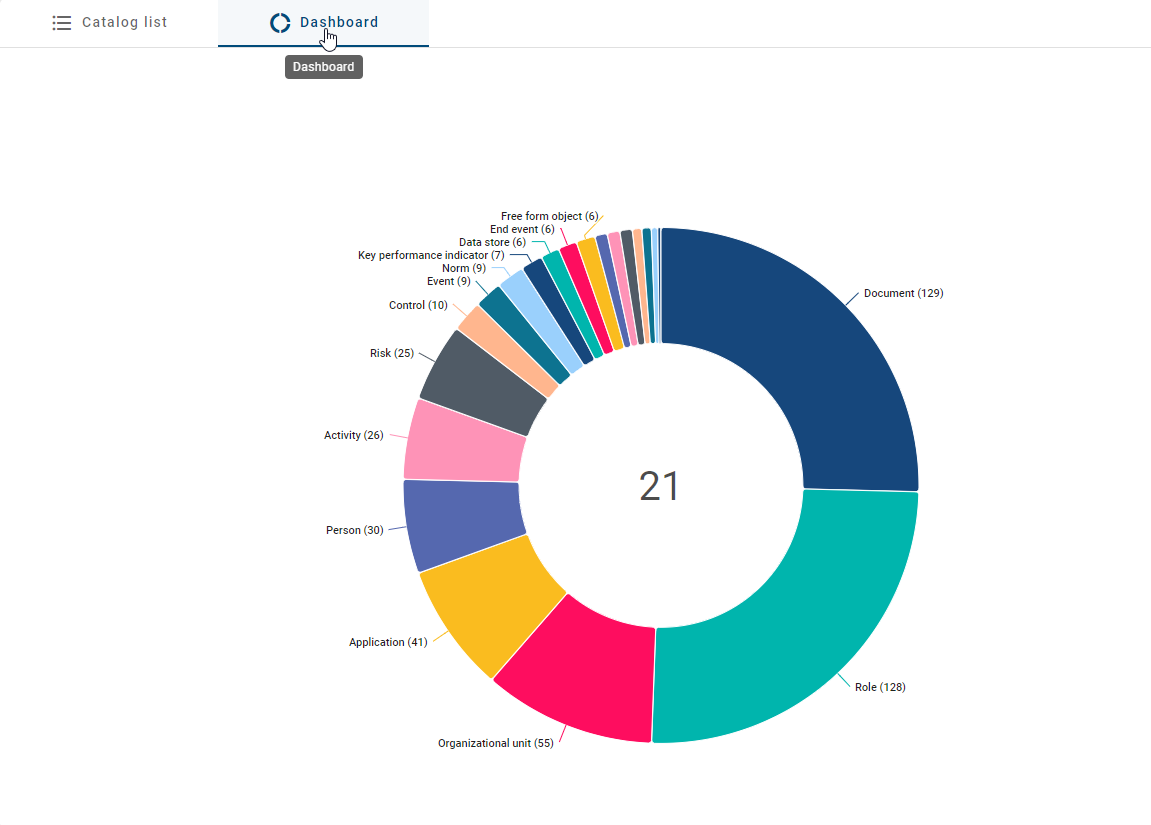
The dashboard opens with a pie chart in which all catalog items are sorted according to the object types. You can highlight individual elements by moving the cursor over an element in the donut chart.
To return to the usual list-based view of the catalog items, select the List tab next to the Dashboard tab.
![]()
Tip
The number displayed in the center of the donut chart shows the the number of different entity types within the catalog.
Which data is offered by the dashboard?
In the dashboard, you can decide whether you want to display an overview of all catalog items of all object types or all facet values of all catalog items that belong to a specific object type.
If you have not selected a filter in the catalog, all catalog items will be displayed, sorted by their object type. In parentheses after the name of the object type, the number of catalog items that exist for this type are shown.

In case you have selected a filter, the facets and their values are displayed for the specific object type. A separate diagram is displayed for each facet. Each of these diagrams shows the different values that exist for the respective facet. Behind each of the values in parentheses you can see the number how often this value was given for the facet.
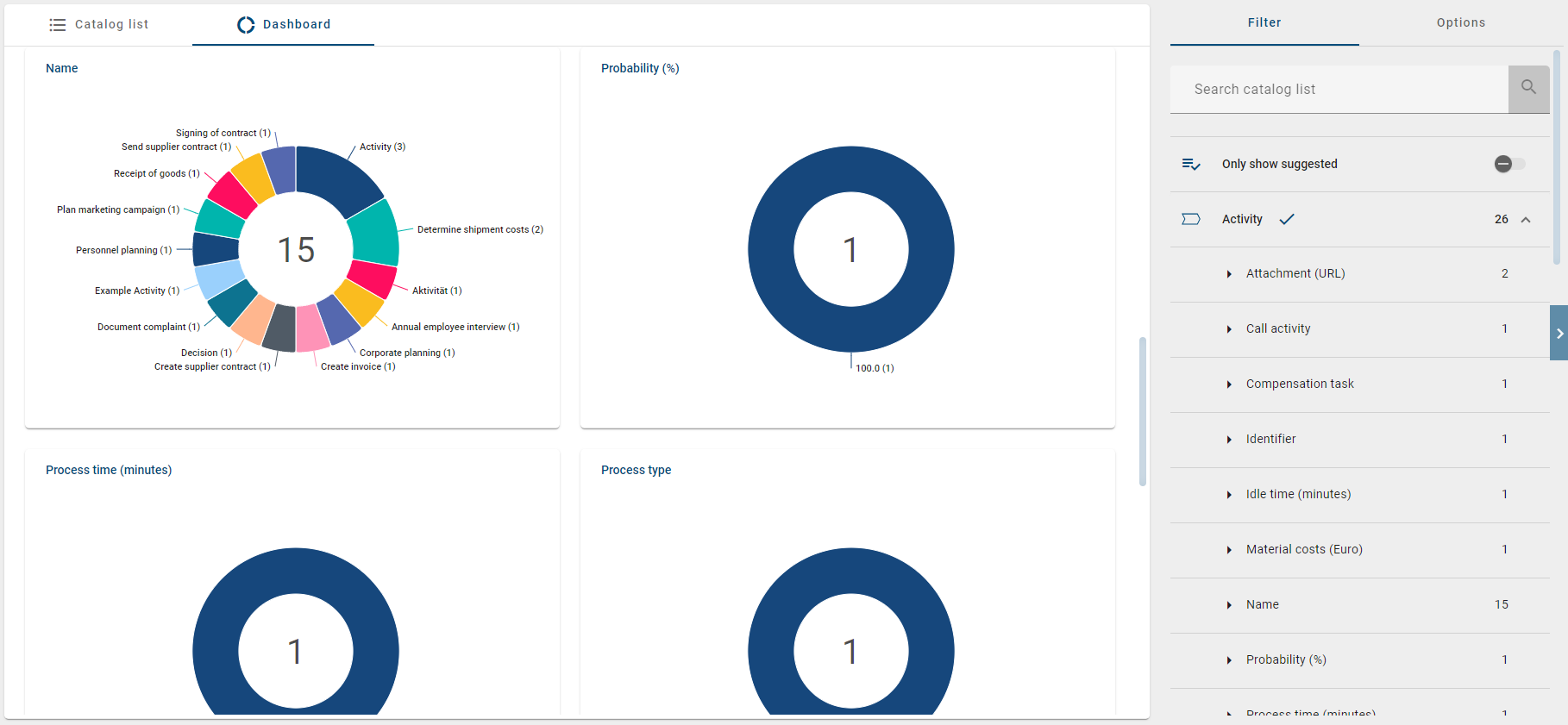
How can I change the chart type in the dashboard?
In the dashboard, you can adjust the chart type to suit your needs. To do so, select the Catalog menu item from the left menu and click the Dashboard tab. An overview of all catalog items, sorted by object type, will then be displayed in the form of a donut chart.
If you select at least one filter in the Filter panel on the right sidebar, a separate donut chart is displayed by default for each facet. You can change the chart type for any of these charts by opening the context menu and selecting the Switch chart type option. You can then choose between three chart types: line chart, donut chart, and column chart. The currently selected chart type is indicated by a checkmark next to its name.
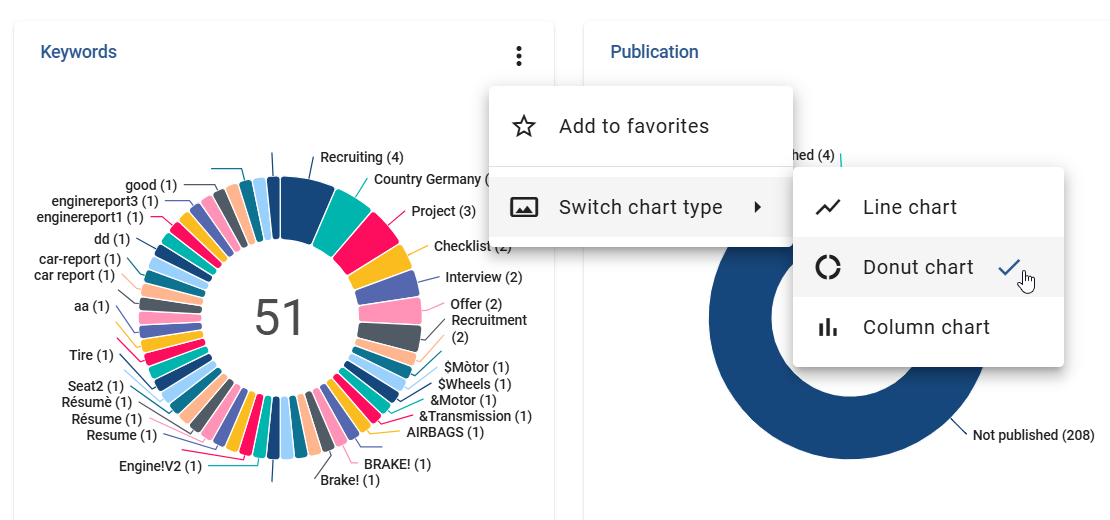
Once you select a chart type, the display of the corresponding tile is updated immediately and the selection is saved automatically. When you reopen the dashboard at a later time, the previously selected chart type will be displayed for the respective tiles.
If you mark the dashboard as a favorite, the currently selected chart type will always be displayed on your myBIC page. For example, if you add the dashboard as a donut chart and later switch it to a line chart, it will also appear as a line chart on your myBIC page.
Lifecycle Roadmap
How can I define the life cycle of a catalog object?
As an Administrator or Editor, you can define the life cycle of a catalog object. To begin, navigate to the public workspace and select a catalog object. Next, switch to edit mode.
In the edit mode, you will see the Life Cycle attribute group, where you can define a start date for various attributes.

Once you have defined and saved the life cycle, and exited edit mode, the Life Cycle attribute group appears to all users as a timeline with the specified dates.

The different colors in the timeline represent the various phases of the lifecycle. Additionally, a marker indicates the current day to provide a clearer overview of the lifecycle. This marker may appear before, within, or after the timeline, depending on the lifecycle dates entered.
To get more detailed information about the life cycle, you can expand the Life Cycle attribute group.
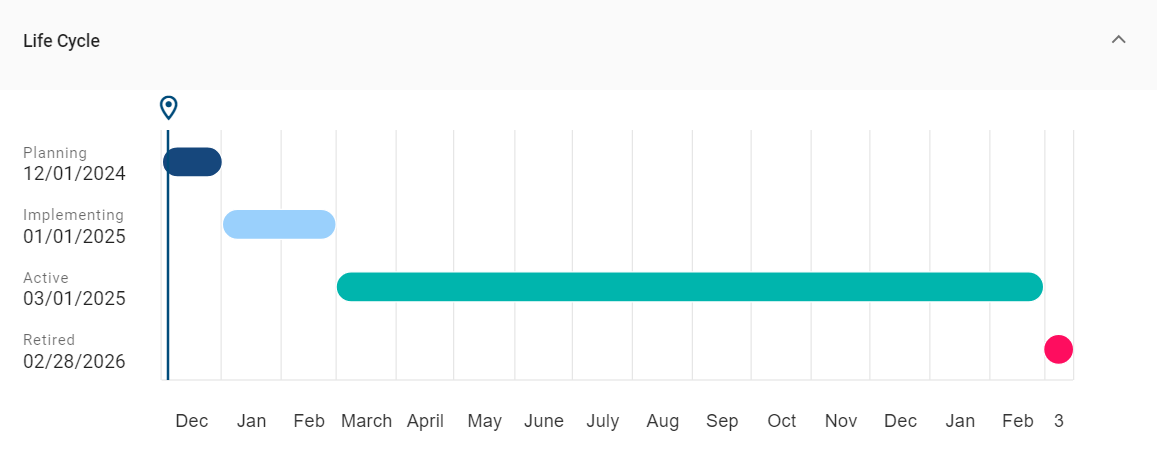
On the left, you will see all the dates entered for the life cycle, which are also displayed as a bar chart on the right. Hovering the mouse over each bar will show the name and exact dates of the attribute.

Hint
Please note that a separate license is required to use this feature.
Where can I view the Lifecycle Roadmap of catalog objects?
You can view the Lifecycle Roadmap of filtered catalog objects. To do so, ensure you are in the public workspace and have selected at least one filter in the right sidebar. When at least one filtered catalog object has the :ref: attribute group “Life Cycle” <lifecycle-catalog-entry>` maintained, the Lifecycle Roadmap tab will appear next to the Dashboard tab.
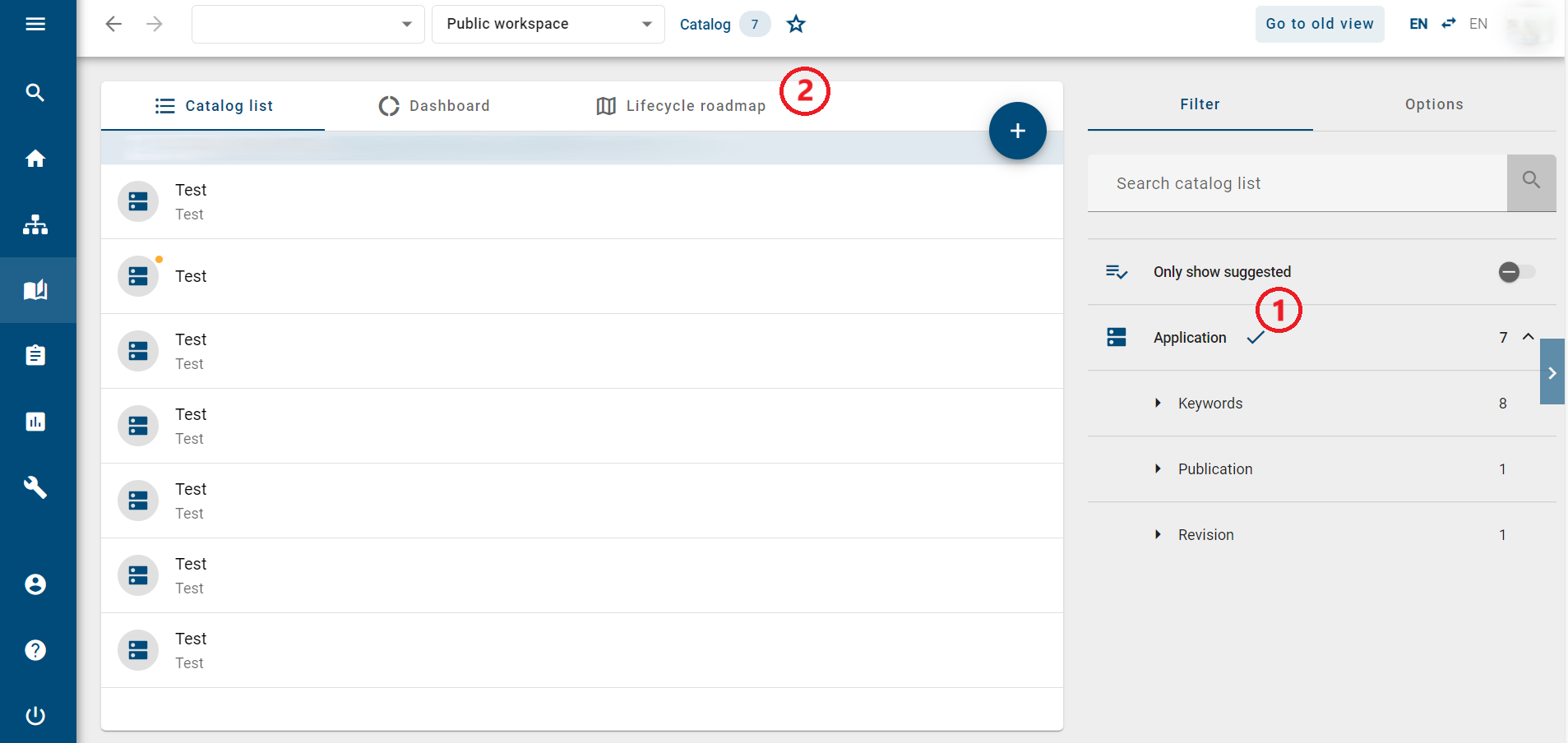
By clicking the Lifecycle Roadmap tab, a lifecycle roadmap will appear, visualizing the timelines of all catalog objects that match the currently selected filter criteria. The catalog objects are listed in descending alphabetical order.
At the top of the roadmap, the years are displayed to illustrate the progression of the lifecycle. On the left side, a sorting panel lets you sort the displayed catalog objects based on various criteria. Regardless of the selected sorting, all catalog objects that match the filter are shown along with their lifecycle. Below the roadmap is a resizable navigator, allowing you to navigate through the entire roadmap and customize its display.

The entire roadmap is displayed, with the currently selected range defaulting to a period of -2 years to today and +3 years. When the view is adjusted, a period of five years is shown by default.
Above the lifecycle roadmap, a legend explains the meaning of the different colors. Each color represents a phase in the catalog object’s lifecycle: Planning, Implementing, Phase In, Active, Phase Out, and Retired. By clicking on a legend item, you can show or hide a corresponding phase in the roadmap. Hidden phases are grayed out in the roadmap.
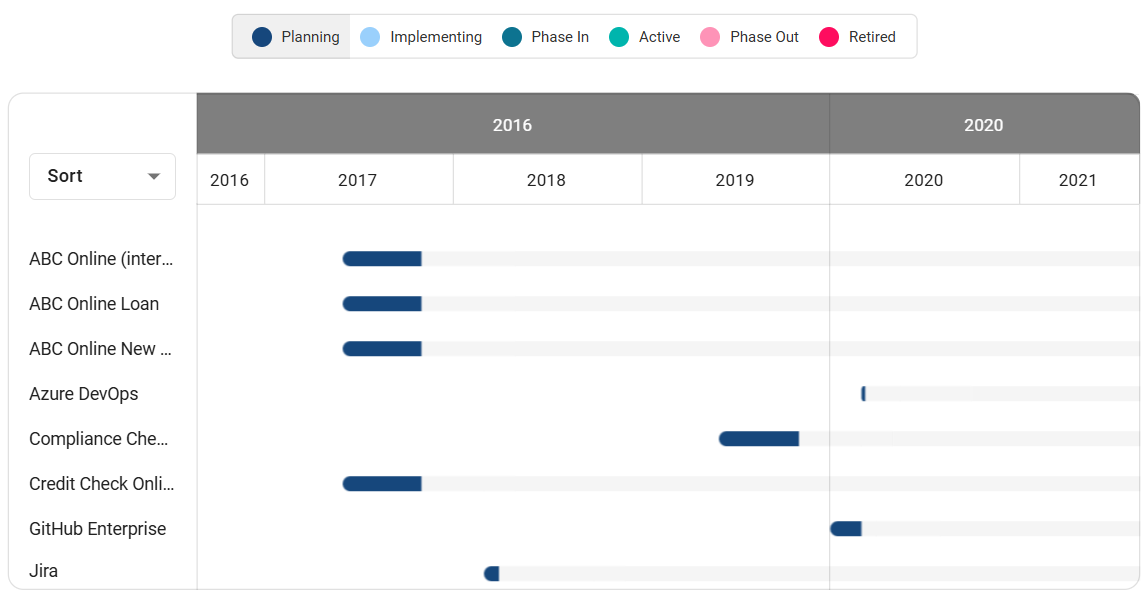
Warning
Please note that a separate license is required to use this feature.
Hint
Please note that when you change the attribute filters for the selected catalog object type, the roadmap is updated to show only the catalog objects that match the new filter criteria.
Integrations
How can I view configured integrations in the catalog?
Users with the Administrator role can integrate so-called Integrations to the catalog. This allows them to embed websites into a new tab for specific catalog object types, displaying external website content within BIC without redirecting the user. Additionally, integrations can be used to reference other content within BIC. To learn how to configure integrations, click here.
If integrations have been configured for specific catalog object types, you must first filter by those object types. You can find the filter option in the Filter tab on the right sidebar. Once filtered, all integrations configured for the selected catalog object type will appear as new tabs next to the default List and Dashboard tabs.
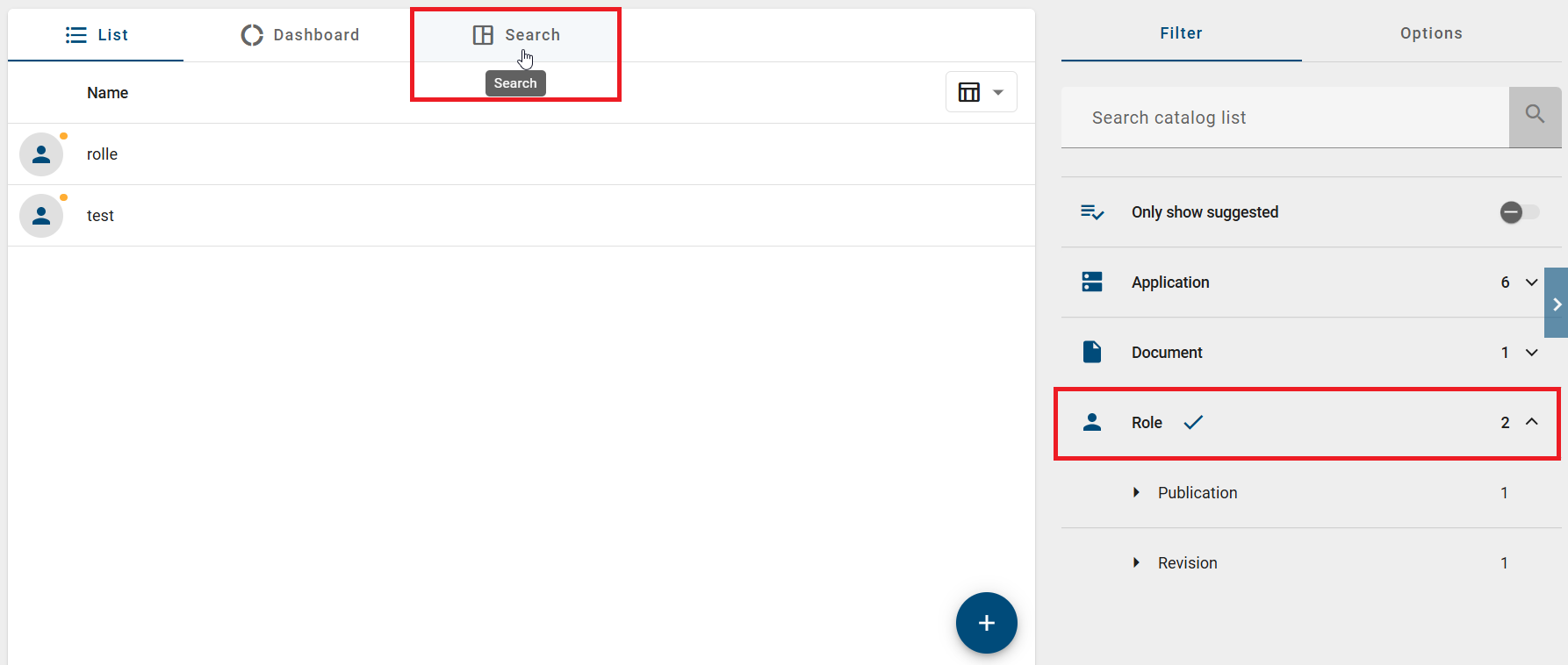
Integration titles are displayed in your browser’s language. If a title is not available in your selected language, it will be shown in English.
Hint
Please note that you can only see the configured integrations if they are not restricted to specific user groups or if you are a member of the assigned user group.
You can then click on the configured integration to display the configured URL within BIC, allowing you to interact with it directly.
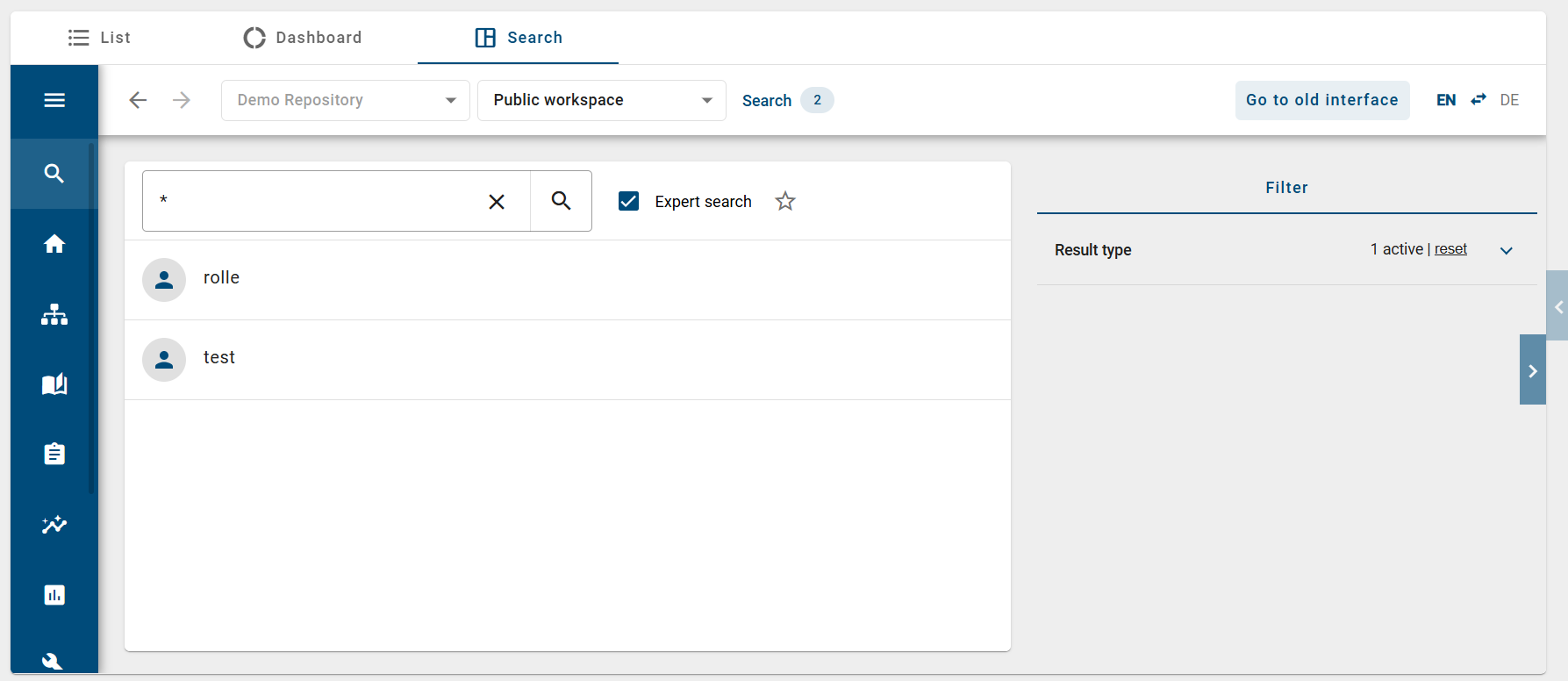
In this example, the search for all entries in the public workspace with the filtered result type “Role” has been linked.
Hint
Please note that the use of integrations requires a separate licence, which you must purchase.
Occurrences
How can I view the relationship of a catalog item to other catalog items?
You can see in the respective details of a catalog item if this item is related to other catalog items. To do this, open a catalog item and select the Occurrences tab in the right sidebar. The appearing facet Catalog can be expanded to view its relationship to other catalog items.
If the catalog item is related to other catalog items, you can view its details by clicking on the corresponding item.
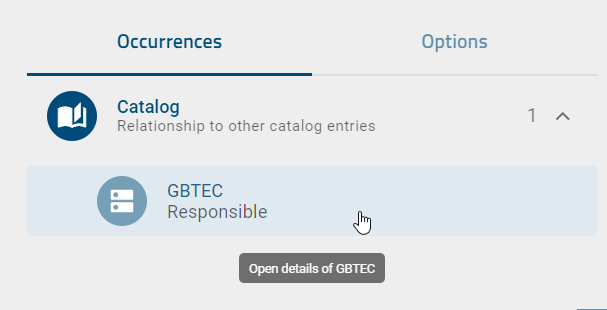
If the catalog item is not related to any other catalog items, you will be notified with the corresponding information.
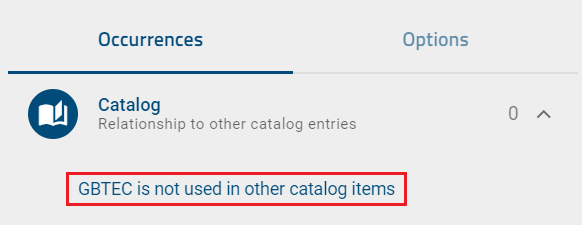
How can I graphically display the relationships of a catalog item to other objects?
Every user can graphically display the relationships of a catalog item to other objects in the form of a tree diagram. To do so, click the Catalog menu item in the left menu and select a catalog item. You will then be taken to the details view of the selected item. To visualize the relationships of this catalog item, switch to the Object relations tab in the header of the details view.

If there are no relationships to other objects for the selected catalog item, you will be informed accordingly. Otherwise, a tree diagram will be displayed, with the selected catalog item as the node at level 0 (left). All found relationships, categorized by object type, are shown as nodes at level 1 (center) and are colored according to the assigned object type colors from BIC.
To display the individual objects of an object type, click on the corresponding object type in level 1. All objects of that type that are related to the selected catalog item will then be displayed at level 2 (right).
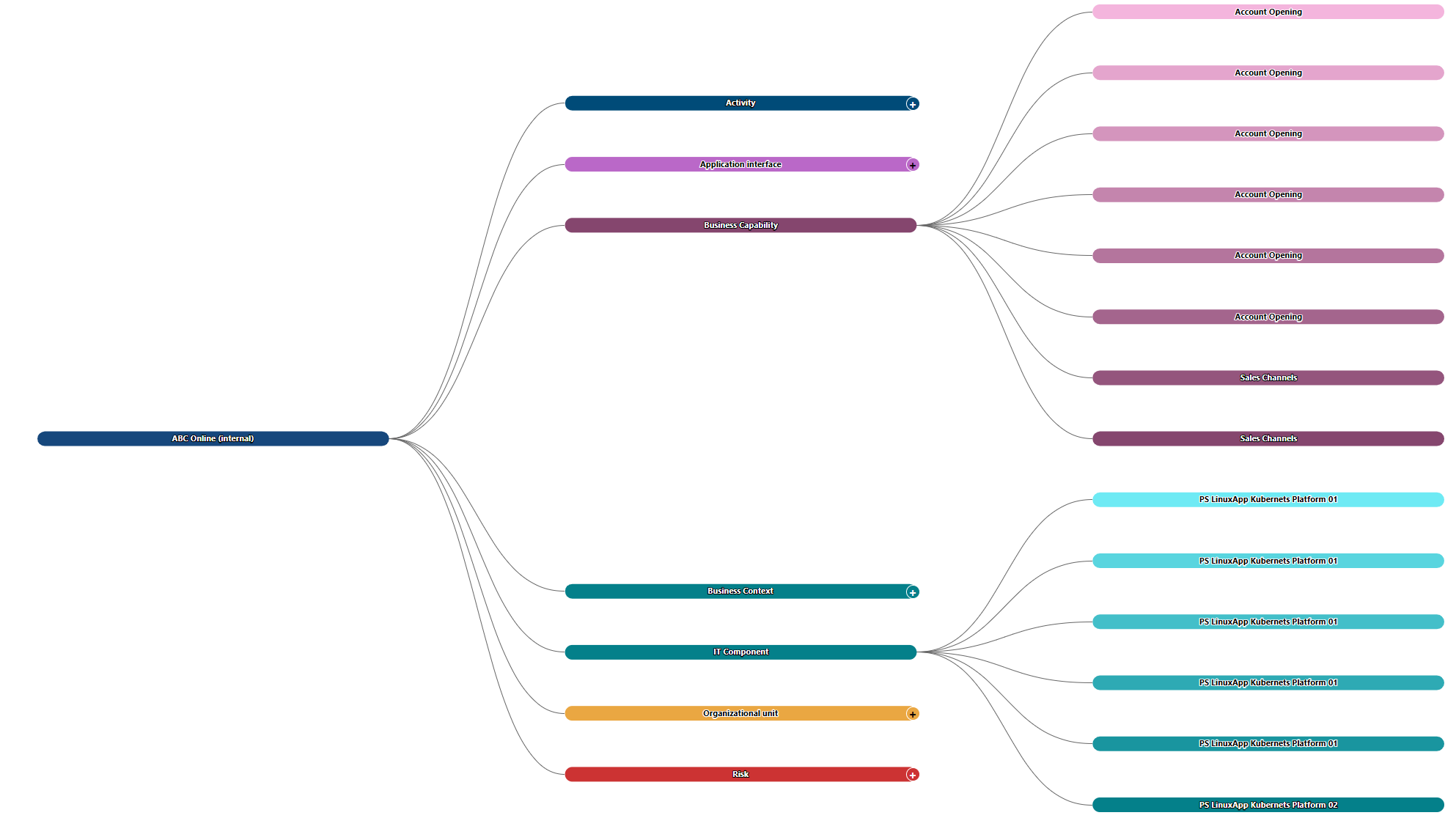
You can also view the most relevant information about an object by hovering your mouse over it in level 2. This information shows whether the object represents a relationship to a diagram or another catalog item, the name of the diagram or catalog item, and, if available, the type of relationship within the diagram.
Alternatively, you can right-click an object in level 2 and select the Go to occurrence button to be taken to the corresponding object in the diagram or catalog where it occurs and view all information about the object.
How can I view occurrences of catalog items in diagrams?
In the catalog, you have the option to view the occurrences of catalog items. In doing so, all occurrences will be displayed, in which diagrams they are used and the relations they have to other objects.
Select the Catalog item in the left menu bar. There select a catalog item to open the details of that item. Within the right sidebar you can see the Occurrences panel. In case it is selected a list of all the occurrences of the item will be displayed.
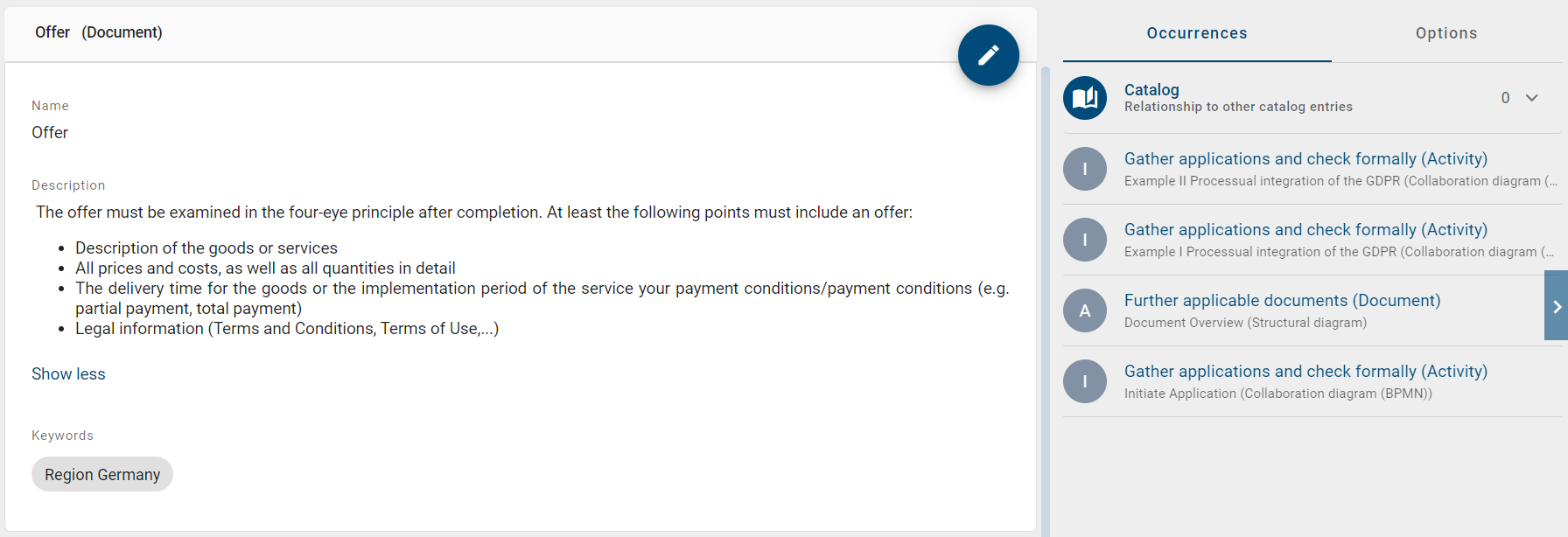
For occurrences with connections to other symbols, the name of the connected symbol and the name of the diagram are displayed. For objects without connections to other objects, only the diagram name is displayed.

Select an occurrence from the list. The diagram or allocation diagram that contains the occurrence will be opened and the symbol will be pre-selected.
You can also display the occurrences of an object in diagrams.
How can I see how a catalog item is used in a diagram?
When you navigate to the catalog list and have selected an item, you have the option Occurances under the details. This option allows you to see the relationships between other catalog items and diagrams.
If the corresponding item is used in a diagram, this diagram is listed in the occurrence list. The list is sorted alphabetically, with each item being an expandable field with the number of occurrences. When the diagram field is expanded, all occurrences of the item are listed. These are clearly presented in ordered groups, each with its own designation.
Hint
To navigate to a specific occurrence of an item, you need to click on that item.
How do I reuse catalog items in multiple diagrams?
You can reuse catalog items in multiple diagrams by using the suggestion list. It does not matter whether the items have already been accepted in the catalog or not (“suggested”).
Create an object type that already exists in the catalog. Edit the name of the object by double-clicking or pressing F2 and type in at least one letter of the catalog item that you want to reuse. All catalog items, up to a maximum of five, appear in the suggestion list of the server containing the entered term. For example, the search term “manager” will also find “process manager”. In addition, the suggestion list is prefiltered by the diagram attribute “Scope”:
Scope defined: Only catalog items whose scope is not defined or which have the same scope as the diagram are found in the suggestion list. Scopes are considered to be the same as soon as an organizational unit exists in both scopes.
Scope not defined: Only catalog items whose scope is not defined are found in the suggestion list.

Select the catalog item that you want to reuse from the suggestion list.
Note
The suggestion list for catalog items in the attributes of an object behaves in the same way. When reusing, note the differences by editing suggested and accepted catalog items.
Catalog Export and Import
How do I create a Process warehouse export in the catalog?
The Process warehouse export contains all currently displayed catalog items in the form of an Excel table. This means that filters, facets or search results can limit the content of the catalog export.
In your menu bar, navigate to the Catalog. In the right sidebar click on the register card Options. There select the option Export to excel. The export will then be created according to the current filtering.

As soon as the report has been generated you get a popup notification which informs you about the successfully created report. There you also get the option to directly download the export. In addition, the function Download the report appears on the right side of the Export to excel function. Via those two options you can download the report.

In the export, the first visible row forms the header, that is, the heading of the following rows. In the first column, the unique identifiers of the catalog items are listed under the heading “Entity ID”. The following columns relate to the attributes of the catalog item. The names of the attribute types represent the headings, for example the name, identifier, description, attachment, keywords, system attributes and the object type. The following rows specify the filled attribute values associated with the catalog items. Multi-value attributes, like keywords, are listed separated by a semicolon. In general, the attribute types are only part of the export if they have been maintained for at least one catalog item.
Hint
Please note that the Process Warehouse export for diagrams does not consider any filters that have been selected.
Hint
In older versions, all attribute types were exported, regardless of whether they were deactivated or removed within the method. From now on, only visible attribute types are exported.
Note
Attribute values exceeding 32767 characters will be automatically shortened. A notification will be provided at the end of the shortened value indicating it has been reduced.
Note
The attribute type IDs, which are defined in the method, are specified in the initially hidden first row. This allows you to re-import the exported data and make changes to catalog items. However, note the following restriction.
Note
Each cell of the column “Attachment (URL)” contains a comma-separated list of the links maintained in the corresponding attribute field. Maintained titles are specified at the corresponding URLs via URL encoding. If you edit (or add) the title of a URL in the process warehouse, be sure to use URL encoding in order to update the catalog item successfully.
Note
The date information you find within your exports (e.g., “Valid from”, “Valid to”, “Created date”, and similar) undergo conversion to the time zone of the currently active user. This ensures that the display of date information always aligns with the user’s current time zone.
Hint
Please note that the Attachment (URL) attribute can be restricted by the individual method configuration. In this case, it is only possible to store links or URLs, while other file types cannot be maintained.
How can I import data into the catalog?
With the rights of the user role “Editor” you can import a (adapted) process warehouse export in csv or xlsx format into the catalog of the public workspace to add or change data. The data is always saved in the current content language.
Navigate to the Catalog via the menu bar and select the desired catalog filter. The catalog filter specifies the object type of the subsequently imported catalog items and must be active for the import. If there are no catalog items of the type you want to import in the current catalog list, please add a catalog item of the desired type to obtain the corresponding filter facet. After filtering for the desired type, switch to the options tab in the right sidebar and select the entry Import.

Open the desired csv or xlsx file via the appearing file selection window. The import is carried out according to the current filtering, recognizable by a corresponding message at the bottom right of the screen. If the data has been imported successfully, you receive another message. Refresh the catalog by clicking on this message to display the imported items in the catalog list. Instead, if the import fails, you will receive a corresponding message without the refresh function.
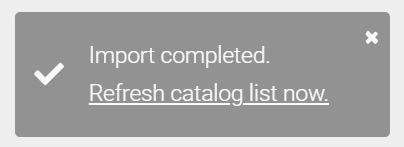
Note
The date information you find within your imports (e.g., “Valid from”, “Valid to”, “Created date”, and similar) undergo conversion to the time zone of the currently active user. This ensures that the display of date information always aligns with the user’s current time zone.
Note
Note that the entries of the “Attachment (URL)” column have to be URL-encoded in order to be imported successfully. Thus, if you like to attach URLs with titles to a catalog item, the titles have to be URL-encoded.
Note
Note that attribute values represented by checkboxes are ignored during import.
Hint
Please note that the Attachment (URL) attribute can be restricted by an individual method configuration. In this case, it is only possible to store links or URLs, while other file types cannot be maintained.
Functionality:
The import process is explained using exported (customized) catalog items. The import file is then structured as follows: The initially hidden first row specifies the attribute type ID for each column, that is defined for an object type in the application and is taken into account for your import. The first visible row, which is the second row in the screenshot, specifies the header. The filled out rows below correspond to the catalog items. This structure basically applies to an import file. In the following example, three catalog items are created during import in the same order as in the file.

Note
Accordingly, when importing in both csv and xlsx format, the catalog items are read in from the third row onwards.
Attributes listed in the import are adopted for the catalog items if the attribute is defined for the corresponding object type in the method: the attribute type and its data type. If this is not the case, the respective attribute type is ignored by the import. The system attributes are set or adjusted automatically at the start of the import and cannot be adjusted manually.
By default, the first column of the import file contains the ENTITY_ID if it is an export. However, if you modify the import file or create it yourself to update or create catalog items, adopt the structure described above and note the following functionality. If the first column of the import file contains the ENTITY_ID or an attribute type ID of type Text (as the header, see example above) and corresponding row entries,
this column is regarded as identifying. It is used for the case-sensitive comparison with catalog items.
the row of the file in the import is skipped if no Universally Unique Identifier (UUID) is used to define the ENTITY_ID. A UUID is a globally unique identifier of numbers and letters which is defined by time and location stamps. The use of an existing UUID or the generation of a new one is necessary for the import with ID and the update functionalities based on it. You can generate a new UUID using a generator (e.g. using the Online UUID Generator Tool).
a new catalog item is created as a suggestion if the ID or text attribute does not already exist in the catalog.
the existing catalog item with the exact same ID or text attribute is updated, that means the attribute types contained in the import are reset for the selected content language. Accordingly, empty or filled cells in the import delete or change the attributes of a catalog item. Attribute types that are not listed in the import remain unaffected in the catalog item. To update via the ID, the corresponding catalog item must be available in the filtered catalog.
If this is not the case for the ENTITY_ID, that means the same ID already exists for a catalog item of another object type, the affected row is skipped in the import.
The adjustment using the attribute type ID does not take into account the existing objects of another object type. However, if the selected filter contains several objects with the exact same attribute text, the affected row is skipped in the import.
If several line entries of the identifying attribute have the same name in the import file, the contents of the first corresponding line entry are updated with the subsequent line entries. Note that using the ENTITY_ID only makes sense in the first column. If the import file contains neither an ENTITY_ID nor a text attribute, it will not be imported.
Format:
For certain attributes, you must note the format. These include date values that must be entered in the format of the current content language.
Note
When importing as an xlsx file or via Excel, it is recommended to format date values in Excel as “date”. Importing as a csv file or as an xlsx file, in which date values are formatted as “text”, allows the following formats per data type.
Attribute value for data type |
Format |
|---|---|
Date |
yyyy-MM-dd |
Datetime |
yyyy-MM-dd HH:mm:ss |
Time |
HH:mm:ss |
Also note that cell representation of numbers in scientific format, that means in exponential notation, is not supported by the import.
Note
The date information you find within your imports (e.g., “Valid from”, “Valid to”, “Created date”, and similar) undergo conversion to the time zone of the currently active user. This ensures that the display of date information always aligns with the user’s current time zone.
Note
The combination of quotation marks and a semicolon (";) in attributes with string values (e.g., the attribute Name, AT_NAME) is not supported by the import. Instead please use commas to separate these attributes.
HTML tags which are used in the attribute Description will be interpreted during the import. The content of the attribute will then be displayed in the desired format after the file has been imported into the catalog. For example, you can specify the description of a document as shown below.

The content of the attribute is then displayed according to the given HTML format after the import into the catalog. Thus, the description attribute of the document “Vacation request” is maintained as follows:
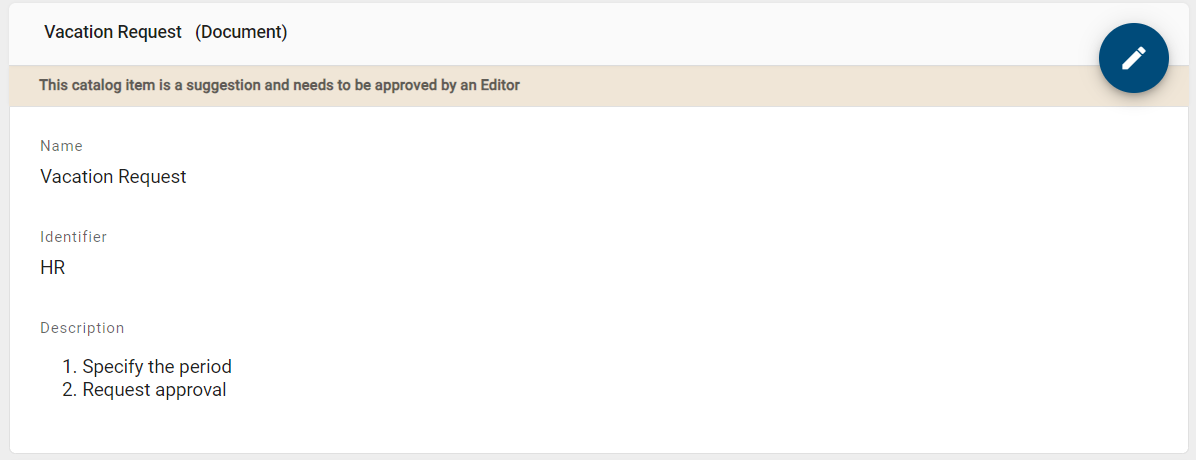
The possibility to convert HTML tags into the desired format only applies to the import. The export cannot process HTML tags and also the formatting is not converted into HTML tags.
Multi-value text attributes, such as keywords, and links are also supported. The individual attribute values must be separated by a semicolon in the import so that they can also be recognized as multiple values. A space before or after the semicolon is not adopted in the attribute value.
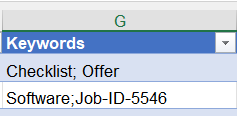
For example, the import above creates the two keywords “Checklist” and “Offer” for the “checklist for an offer” document and shows them in alphabetical order.

Note
Since all catalog items are created during the import as object types of the selected filter, the imported file should also contain only this object type. Furthermore, the files (xlsx, csv) should be UTF-8 encoded. When importing an xlsx file, only the first spreadsheet is taken into account.
Hint
Please note that you cannot maintain or update assignments (like an assigned diagram in the subprocess attribute or person/ organizational units in the governance attributes author/examiner/responsible) via the catalog import. If you update existing catalog items via an import, the current assignments in BIC Process Design are not overwritten (and new ones are not added).
How can I export the profile of a catalog item?
Go to the Catalog and navigate to the catalog item for which you want to create a profile. With this you will enter the item’s details view. There, in the right sidebar, navigate to the register card Options and select the Profile option. The creation will then be started.

As soon as the report has been generated you get a popup notification which informs you about the successfully created report. There you also get the option to directly download the profile. In addition, the Download the report function appears on the right side of the Profile entry. Via those two options you can download the docx file.

The profile is available in the catalog for the object types defined in the administration area. Administrators and Editors can retrieve it.
Note
In general, the availability for the profile depends on the configuration in the corresponding report descriptor.
It lists all attributes that have an attribute value and the corresponding value in alphabetical order and is created in the current content language of the application. You do not see the values of assignment attributes as titles, but the actual assignment, such as a URL.
Hint
Please note that a catalog item used as an attribute is not currently evaluated in the profile report for catalog items. Currently, only the occurrences and associations of a catalog item that are modeled in a diagram are displayed.
Hint
The date information you find within your exports (e.g., “Valid from”, “Valid to”, “Created date”, and similar) undergo conversion to the time zone of the currently active user. This ensures that the display of date information always aligns with the user’s current time zone.
Note
If the report template does not exist in the selected content language, the English template is used. The maintained attribute values remain in the content language.
Delete catalog items
How do I delete a catalog item?
Catalog items which are no longer needed can be deleted from the catalog. This is possible for catalog suggestions and accepted catalog items. Deleting a catalog item is irrevocable! Navigate to the desired catalog item in the catalog list and open its context menu. Select the option Delete in the menu.

The option Delete is also available in the right sidebar if you open the catalog item (i.e. in its detail view).

After selecting the option, a dialog window appears to confirm or cancel the deletion. If the catalog item is neither used as an object in a diagram nor assigned to an attribute, the item will be deleted directly.

Catalog item in usage: If the catalog item has at least one occurrence in a diagram, an existing catalog item has to be chosen as a replacement. A second dialog appears which includes an input field. Enter and select an existing item of the same type via the selection list. You can confirm the dialog via the Replace button as soon as you chose an item as a replacement.
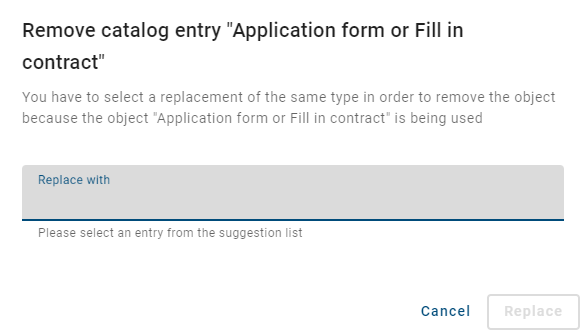
Assigned catalog item: In case the catalog item is at least assigned to one attribute (but not in usage as an object), you can decide to remove or replace the item in a second dialog. For example, this might be person objects in governance attributes. Choosing the option Replace, you can enter and select an existing item of the same type via the selection list in the input field. This item will replace the deleted catalog item after you confirmed the button Replace. Alternatively, you can directly and irrevocably Remove the catalog item. The corresponding assignments in the attributes of other objects or diagrams will be deleted as well. This is executed as soon as you confirm the dialog.

Afterwards, you will return to the catalog list. If an item was deleted in the catalog list, it is crossed and greyed out. When the page is updated, the item disappears from the list.
How can all unused catalog items be deleted?
With the function Reorganize all unused catalog items of a special object type can be deleted. This includes all catalog items that are neither modeled nor used in attributes as subprocesses. The user roles administrator and editor are authorized to delete catalog items.
Navigate to the catalog list. You can find the Reorganize option in the options tab in the right sidebar. Reorganizing the catalog is only possible in combination with an active object type filter. Therefore select the filter facet of the object type, for which you want to delete unused items. Afterwards click the Reorganize option.

You have to confirm the reorganization in the appearing dialog. If you are sure that you want to delete all unused catalog items of the selected type, enter the name of the selected object type in the input field. Your input must match the type name from the current method in your current browser language (i.e. the UI language). Note that the check is case-sensitive. If your input is correct, you can confirm the reorganization of the selected type via the corresponding button.
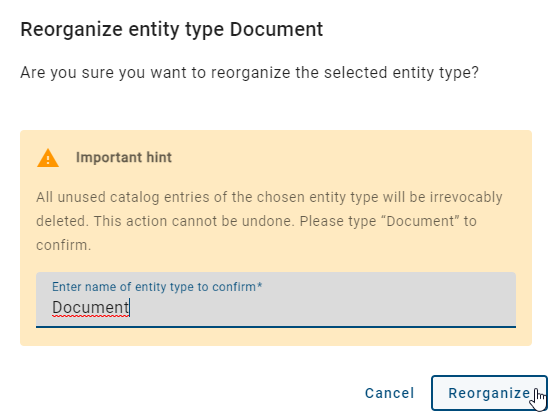
Hint
Please note that the input is case insensitive.
All unused catalog items will be permanently removed from the catalog. Deleted items will be shown crossed out. When the page is updated, the item disappears from the list.
Warning
Please note that the “Reorganize” function affects all unused catalog items of an object type, regardless of which facets were selected in addition to the filter.
Note
The option Reorganize is not available for small screen sizes (e. g. in the mobile view).